Dynabook UPA3613WL 802.11b/g PCIExpress Minicard User Manual NB100 Series User s Guide
Toshiba Corporation 802.11b/g PCIExpress Minicard NB100 Series User s Guide
Dynabook >
User manual

GMAD00196010
08/08
If you need assistance:
❖Toshiba’s Support Web site
pcsupport.toshiba.com
❖Toshiba Customer Support Center
Calling within the United States (800) 457-7777
Calling from outside the United States (949) 859-4273
For more information, see “If Something Goes Wrong” on page 68
in this guide.
NB100 Series
User’s Guide

2
5.375 x 8.375 ver 2.3
Handling the cord on this product will expose you to lead, a
chemical known to the State of California to cause birth defects or
other reproductive harm. Wash hands after handling.
Model: NB100 Series
Protection of Stored Data
For your important data, please make periodic back-up copies of all the data
stored on the hard disk or other storage devices as a precaution against possible
failures, alteration, or loss of the data. IF YOUR DATA IS ALTERED OR
LOST DUE TO ANY TROUBLE, FAILURE OR MALFUNCTION OF
THE HARD DISK DRIVE OR OTHER STORAGE DEVICES AND THE
DATA CANNOT BE RECOVERED, TOSHIBA SHALL NOT BE
LIABLE FOR ANY DAMAGE OR LOSS OF DATA, OR ANY OTHER
DAMAGE RESULTING THEREFROM. WHEN COPYING OR
TRANSFERRING YOUR DATA, PLEASE BE SURE TO CONFIRM
WHETHER THE DATA HAS BEEN SUCCESSFULLY COPIED OR
TRANSFERRED. TOSHIBA DISCLAIMS ANY LIABILITY FOR THE
FAILURE TO COPY OR TRANSFER THE DATA CORRECTLY.
Critical Applications
The computer you have purchased is not designed for any “critical applications.”
“Critical applications” means life support systems, medical applications,
connections to implanted medical devices, commercial transportation, nuclear
facilities or systems or any other applications where product failure could lead to
injury to persons or loss of life or catastrophic property damage.
ACCORDINGLY, TOSHIBA, ITS AFFILIATES AND SUPPLIERS
DISCLAIM ANY AND ALL LIABILITY ARISING OUT OF THE USE
OF THE COMPUTER PRODUCTS IN ANY CRITICAL
APPLICATIONS. IF YOU USE THE COMPUTER PRODUCTS IN A
CRITICAL APPLICATION, YOU, AND NOT TOSHIBA, ASSUME
FULL RESPONSIBILITY FOR SUCH USE.

3
5.375 x 8.375 ver 2.3
FCC Notice “Declaration of Conformity Information”
This equipment has been tested and found to comply with the limits for a Class B
digital device, pursuant to Part 15 of the FCC rules. These limits are designed to
provide reasonable protection against harmful interference in a residential
installation.
This equipment generates, uses and can radiate radio frequency energy and, if not
installed and used in accordance with the instructions, it may cause harmful
interference to radio communications. However, there is no guarantee that
interference will not occur in a particular installation. If this equipment does
cause harmful interference to radio or television reception, which can be
determined by turning the equipment off and on, the user is encouraged to try to
correct the interference by one or more of the following measures:
❖Reorient or relocate the receiving antenna.
❖Increase the separation between the equipment and receiver.
❖Connect the equipment to an outlet on a circuit different from that to which
the receiver is connected.
❖Consult the dealer or an experienced radio/TV technician for help.
Only Peripherals complying with the FCC Class B limits may be attached to this
equipment. Operation with noncompliant peripherals or peripherals not
recommended by Toshiba is likely to result in interference to radio and TV
reception. Shielded cables must be used between the external devices and the
computer's ports. Changes or modifications made to this equipment not expressly
approved by Toshiba or parties authorized by Toshiba could void the user's
authority to operate the equipment.
This device complies with Part 15 of the FCC Rules. Operation is subject to the
following two conditions:
❖This device may not cause harmful interference.
❖This device must accept any interference received, including interference
that may cause undesired operation.
Contact either:
❖Toshiba’s Support Web site at pcsupport.toshiba.com.
❖Or call the Toshiba Customer Support Center:
Within the United States at (800) 457-7777
Outside the United States at (949) 859-4273
NOTE
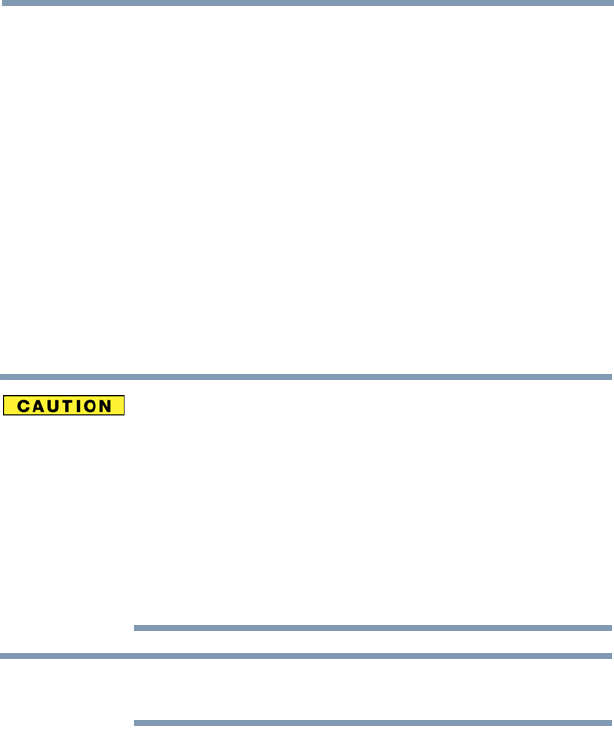
4
5.375 x 8.375 ver 2.3
Industry Canada Requirement
This Class B digital apparatus complies with Canadian ICES-003.
Cet appareil numérique de la classe B est conformé à la norme NMB-003 du
Canada.
Wireless Interoperability
The TOSHIBA Wireless LAN Mini PCI Card products are designed to be
interoperable with any wireless LAN product that is based on Direct Sequence
Spread Spectrum (DSSS) radio technology, and is compliant to:
❖The IEEE 802.11 Standard on Wireless LANs (Revision A/B/G), as defined
and approved by the Institute of Electrical and Electronics Engineers.
❖The Wireless Fidelity (Wi-Fi®) certification as defined by the Wi-Fi Alliance.
The “Wi-Fi CERTIFIED” logo is a certification mark of the Wi-Fi Alliance.
Bluetooth® and Wireless LAN devices operate within the same radio
frequency range and may interfere with one another. If you use Bluetooth and
Wireless LAN devices simultaneously, you may occasionally experience a
less than optimal network performance or even lose your network
connection.
If you should experience any such problem, immediately turn off your
Bluetooth or Wireless LAN device.
Please contact Toshiba computer product support on Web site
http://www.toshiba-europe.com/computers/tnt/bluetooth.htm in Europe or
pcsupport.toshiba.com in the United States for more information.
The above caution applies to products that operate with an 802.11a radio
device.
Wireless LAN and Your Health
Wireless LAN products, like other radio devices, emit radio frequency
electromagnetic energy. The level of energy emitted by Wireless LAN devices
however is far much less than the electromagnetic energy emitted by wireless
devices like for example mobile phones.
Because Wireless LAN products operate within the guidelines found in radio
frequency safety standards and recommendations, TOSHIBA believes Wireless
LAN is safe for use by consumers. These standards and recommendations reflect
the consensus of the scientific community and result from deliberations of panels
and committees of scientists who continually review and interpret the extensive
research literature.
NOTE
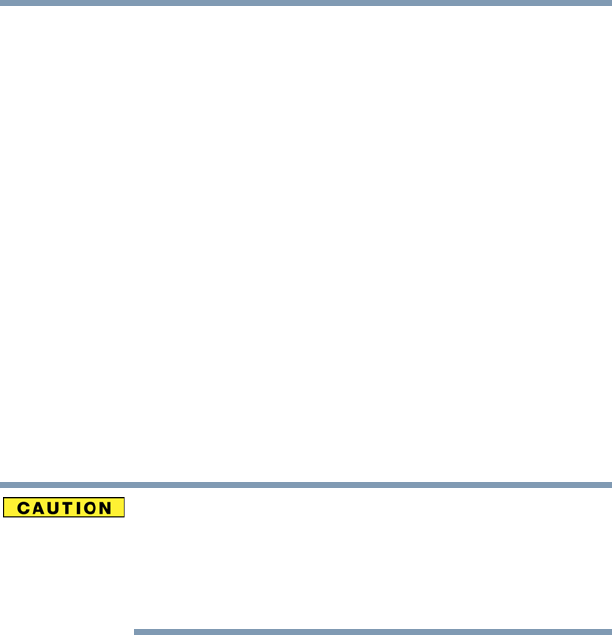
5
5.375 x 8.375 ver 2.3
In some situations or environments, the use of Wireless LAN may be restricted
by the proprietor of the building or responsible representatives of the
organization. These situations may for example include:
❖Using the Wireless LAN equipment on board airplanes, or
❖In any other environment where the risk of interference to other devices or
services is perceived or identified as harmful.
If you are uncertain of the policy that applies on the use of wireless devices in a
specific organization or environment (e.g. airports), you are encouraged to ask for
authorization to use the Wireless LAN device prior to turning on the equipment.
Regulatory Information
The TOSHIBA Wireless LAN Mini PCI Card must be installed and used in strict
accordance with the manufacturer’s instructions as described in the user
documentation that comes with the product. This device complies with the
following radio frequency and safety standards.
Canada – Industry Canada (IC)
This device complies with RSS 210 of Industry Canada.
The installer of this radio equipment must ensure that the antenna is located
or pointed such that it does not emit RF field in excess of Health Canada
limits for the general population; consult Safety Code 6, obtainable from
Health Canada’s Web site www.hc-sc.gc.ca/rpb. The RF device shall not be
co-located with any other transmitter that has not been tested with this
device.
Operation is subject to the following two conditions: (1) this device may not
cause interference, and (2) this device must accept any interference, including
interference that may cause undesired operation of this device.
L’ utilisation de ce dispositif est soumis aux deux conditions suivantes: (1) il ne
doit pas produire de brouillage et (2) l’utilisateur du dispositif doit être prêt à
accepter tout brouillage radioélectrique reçu, même s’il est susceptible de
compromettre son fonctionnement.
The term “IC” before the equipment certification number only signifies that the
Industry Canada technical specifications were met.
To prevent radio interference to the licensed service, this device is intended to be
operated indoors and away from windows to provide maximum shielding.
Equipment (or its transmit antenna) that is installed outdoors is subject to
licensing.
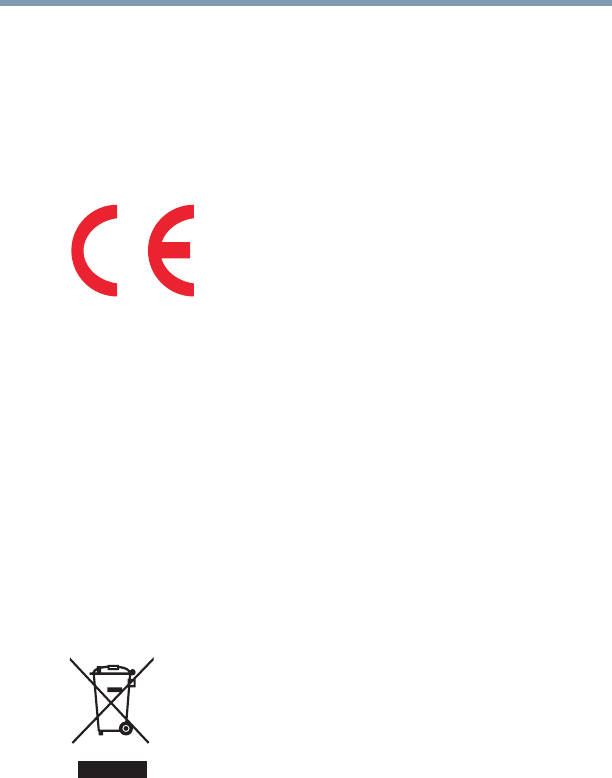
6
5.375 x 8.375 ver 2.3
Pour empecher que cet appareil cause du brouillage au service faisant l’objet
d’une licence, il doit etre utilize a l’interieur et devrait etre place loin des fenetres
afin de Fournier un ecram de blindage maximal. Si le matriel (ou son antenne
d’emission) est installe a l’exterieur, il doit faire l’objet d’une licence.
EU Declaration of Conformity
TOSHIBA declares that this product conforms to the following Standards:
This product is carrying the CE-Mark in accordance with the related European
Directives. The party responsible for CE-Marking is TOSHIBA Europe GmbH,
Hammfelddamm 8, 41460 Neuss, Germany.
The European Union WEEE (Waste from Electrical and
Electronic Equipment) Directive Information
The European Union WEEE (Waste from Electrical and Electronic Equipment)
Directive is intended to protect the quality of the environment and human health
through the responsible use of natural resources and the adoption of waste
management strategies that focus on recycling and reuse. This Directive requires
producers of electrical and electronic products put on the market in European
Union (EU) member countries after August 2005 to mark such products with a
crossed-out wheeled bin symbol.
In the European Union, this symbol indicates that when the last end user wishes
to discard this product, it must be sent to appropriate facilities for recovery and
recycling. This Directive applies to EU member countries only and does not
apply to end users in other countries such as the United States.
Although the initial emphasis is in Europe, Toshiba is already working with
design engineers, suppliers, and other partners to determine appropriate
worldwide product life cycle planning and end-of-life strategies for our products.
Please contact your local government for applicable laws and regulations
governing the disposal of this product. For information on how to trade-in or
recycle your product, visit www.reuse.toshiba.com.
Supplementary
Information:
*The product complies with the
requirements of the Low Voltage
Directive 73/23/EEC, the EMC Directive
89/336/EEC and/or the R&TTE Directive
1999/5/EC.
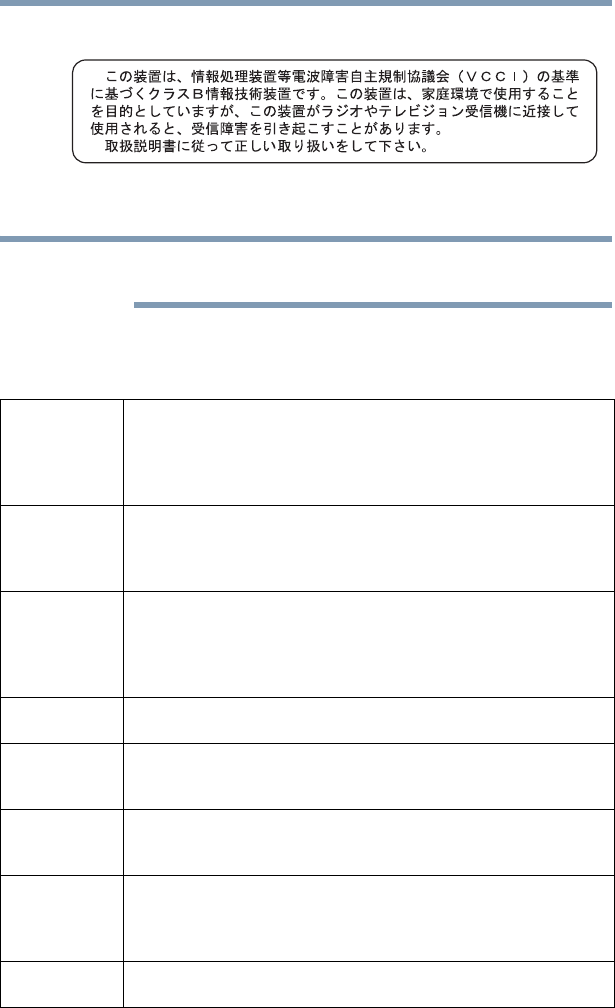
7
5.375 x 8.375 ver 2.3
VCCI Class B Information
Radio Approvals for Wireless Devices
The following information is dependent on what type of wireless device is in
your computer. Not all devices are available on all models.
Europe - Restrictions for use of 2.4 GHz Frequencies in
European Community Countries
België/
Belgique: For private usage outside buildings across public grounds over less than
300m no special registration with IBPT/BIPT is required. Registration to
IBPT/BIPT is required for private usage outside buildings across public
grounds over more than 300m. For registration and license please
contact IBPT/BIPT.
Voor privé-gebruik buiten gebouw over publieke groud over afstand
kleiner dan 300m geen registratie bij BIPT/IBPT nodig; voor gebruik
over afstand groter dan 300m is wel registratie bij BIPT/IBPT nodig.
Voor registratie of licentie kunt u contact opnemen met BIPT.
Dans le cas d’une utilisation privée, à l’extérieur d’un bâtiment, au-
dessus d’un espace public, aucun enregistrement n’est nécessaire pour
une distance de moins de 300m. Pour une distance supérieure à 300m un
enregistrement auprès de l’IBPT est requise. Pour les enregistrements et
licences, veuillez contacter l’IBPT.
Deutschland: License required for outdoor installations. Check with reseller for
procedure to follow.
Anmeldung im Outdoor-Bereich notwendig, aber nicht
genehmigungspflichtig. Bitte mit Händler die Vorgehensweise
abstimmen.
France: Restricted frequency band: only channels 1 to 7 (2400 MHz and 2454
MHz respectively) may be used outdoors in France. Please contact
A.R.T. (http://www.art-telecom.fr) for applicable procedures to follow.
Bande de fréquence restreinte: seuls les canaux 1- 7 (2400 et 2454 MHz
respectivement) doivent être utilisés endroits extérieur en France. Vous
pouvez contacter l’Autorité de Régulation des Télécommunications
(http://www.art-telecom.fr) pour la procédure à suivre.
Italia: License required for indoor use. Use with outdoor installations not
allowed.
NOTE
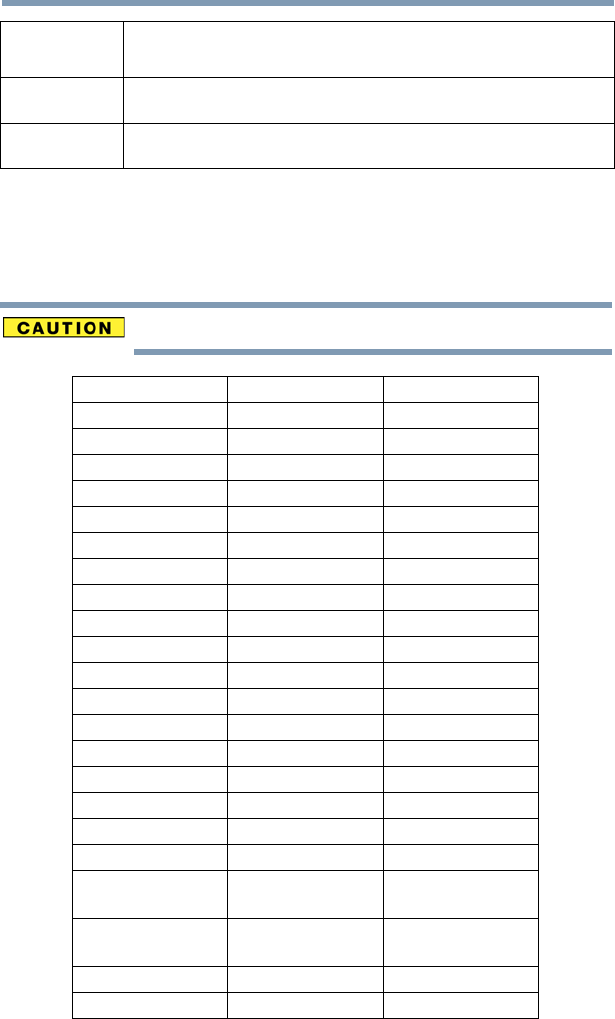
8
5.375 x 8.375 ver 2.3
Approved Countries/Regions for use for the Atheros AR5BXB63
11b/g minicard
This equipment is approved to the radio standard by the countries/regions in the
following table.
Do not use this equipment except in the countries/regions in the following table.
È necessaria la concessione ministeriale anche per l’uso interno.
Verificare con i rivenditori la procedura da seguire.
Nederland: License required for outdoor installations. Check with reseller for
procedure to follow.
Licentie verplicht voor gebruik met buitenantennes. Neem contact op
met verkoper voor juiste procedure.
Argentina Australia Austria
Azerbaijan Bahrain Belgium
Brazil Brunei Canada
Chile China (PRC) Colombia
Costa Rica Cyprus Czech Republic
Denmark Ecuador Egypt
Finland France Germany
Greece Honduras Hong Kong
Hungary Iceland India
Indonesia Ireland Italy
Jamaica Japan Jordan
Latvia Lithuania Luxembourg
Malta Mexico Montenegro
Netherlands New Zealand Norway
Pakistan Panama Peru
Philippines Poland Portugal
Russia Saudi Arabia Serbia
Slovakia Slovenia South Korea
Spain Sri Lanka Sweden
Switzerland/
Liechtenstein
Taiwan (ROC) Thailand
UAE (United Arab
Emirates)
Ukraine United Kingdom
Uruguay USA Venezuela
Vietnam
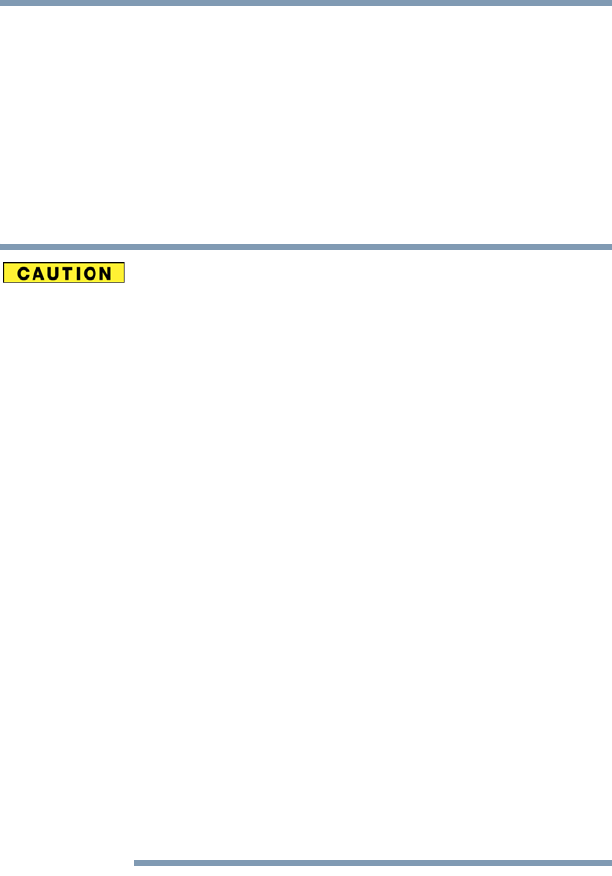
9
5.375 x 8.375 ver 2.3
Bluetooth® Wireless Technology Interoperability
Bluetooth® Cards from TOSHIBA are designed to be interoperable with any
product with Bluetooth wireless technology that is based on Frequency Hopping
Spread Spectrum (FHSS) radio technology, and is compliant to:
❖Bluetooth Specification as defined and approved by The Bluetooth Special
Interest Group.
❖Logo certification with Bluetooth wireless technology as defined by The
Bluetooth Special Interest Group.
Bluetooth wireless technology is a new innovative technology, and TOSHIBA has
not confirmed compatibility of its Bluetooth products with all computers and/or
equipment using Bluetooth wireless technology other than TOSHIBA portable
computers.
Always use Bluetooth cards from TOSHIBA in order to enable wireless
networks over two or more (up to a total of seven) TOSHIBA portable
computers using these cards. Please contact TOSHIBA computer product
support on Web site
http://www.toshiba-europe.com/computers/tnt/bluetooth.htm in Europe or
pcsupport.toshiba.com in the United States for more information.
When you use Bluetooth cards from TOSHIBA close to 2.4 GHz Wireless
LAN devices, Bluetooth transmissions might slow down or cause errors. If
you detect certain interference while you use Bluetooth cards from TOSHIBA,
always change the frequency, move your computer to the area outside of the
interference range of 2.4 GHz Wireless LAN devices (40 meters/43.74 yards
or more) or stop transmitting from your computer. Please contact TOSHIBA
computer product support on Web site
http://www.toshiba-europe.com/computers/tnt/bluetooth.htm in Europe or
pcsupport.toshiba.com in the United States for more information.
Bluetooth and Wireless LAN devices operate within the same radio frequency
range and may interfere with one another. If you use Bluetooth and Wireless
LAN devices simultaneously, you may occasionally experience a less than
optimal network performance or even lose your network connection. If you
should experience any such problem, immediately turn off either one of your
Bluetooth or Wireless LAN.
Please contact Toshiba computer product support on Web site
http://www.toshiba-europe.com/computers/tnt/bluetooth.htm in Europe or
pcsupport.toshiba.com in the United States for more information.
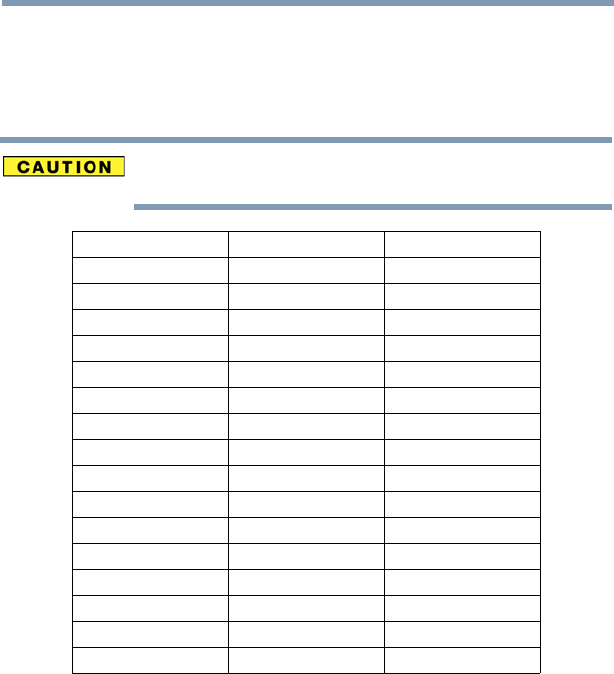
10
5.375 x 8.375 ver 2.3
Approved Countries/Regions for use (Bluetooth® wireless
technology)
Bluetooth® Card from Toshiba equipment is approved to the radio standard by the
countries/regions in the following table.
Do not use this equipment except in the countries/regions in the following
table.
Bluetooth® Wireless Technology and Your Health
The products with Bluetooth® wireless technology, like other radio devices, emit
radio frequency electromagnetic energy. The level of energy emitted by devices
with Bluetooth wireless technology however is much less than the
electromagnetic energy emitted by wireless devices such as mobile phones.
Because products with Bluetooth wireless technology operate within the
guidelines found in radio frequency safety standards and recommendations,
TOSHIBA believes Bluetooth wireless technology is safe for use by consumers.
These standards and recommendations reflect the consensus of the scientific
community and result from deliberations of panels and committees of scientists
who continually review and interpret the extensive research literature.
Argentina Australia Austria
Belgium Bulgaria Canada
Chile China Cyprus
Czech Republic Denmark Egypt
Estonia Finland France
Germany Greece Hong Kong
Hungary Iceland Ireland
Italy Japan Jordan
Korea Kuwait Latvia
Lebanon Liechtenstein Lithuania
Luxembourg Malta Netherlands
New Zealand Norway Oman
Peru Philippines Poland
Portugal Singapore Slovakia
Slovenia Spain Sweden
Switzerland Thailand UK
Uruguay USA Venezuela
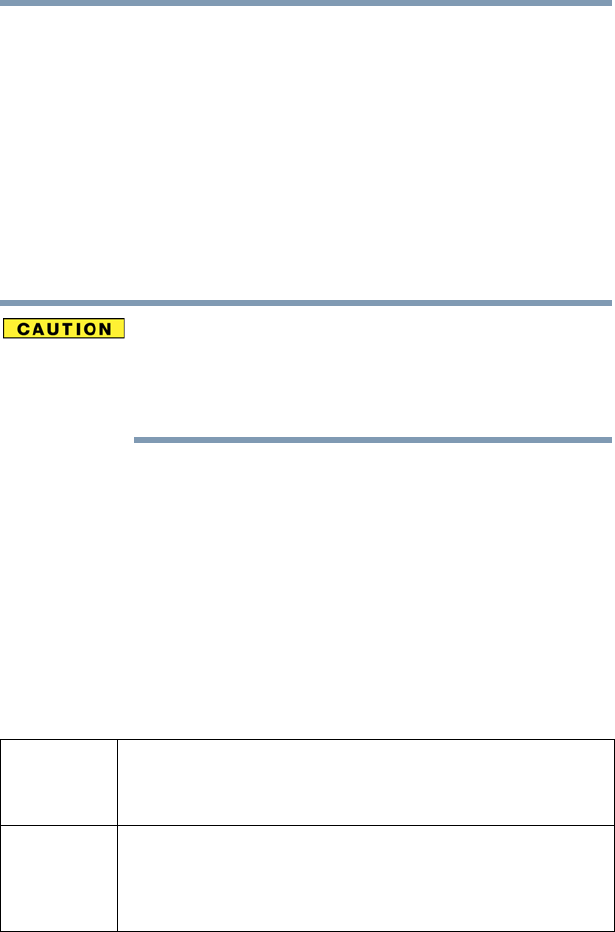
11
5.375 x 8.375 ver 2.3
In some situations or environments, the use of Bluetooth wireless technology
may be restricted by the proprietor of the building or responsible representatives
of the organization. These situations may for example include:
❖Using the equipment with Bluetooth wireless technology on board
airplanes, or
❖In any other environment where the risk of interference to other devices or
services is perceived or identified as harmful.
If you are uncertain of the policy that applies on the use of wireless devices in a
specific organization or environment (e.g. airports), you are encouraged to ask for
authorization to use the device with Bluetooth wireless technology prior to
turning on the equipment.
Exposure to Radio Frequency Radiation
The radiated output power of the Bluetooth Card from TOSHIBA is far below
the FCC radio frequency exposure limits. Nevertheless, the Bluetooth Card
from TOSHIBA shall be used in such a manner that the potential for human
contact during normal operation is minimized.
Regulatory statements
This product complies with any mandatory product specification in any country/
region where the product is sold. In addition, the product complies with the
following:
European Union (EU) and EFTA
This equipment complies with the R&TTE directive 1999/5/EC and has been
provided with the CE mark accordingly.
Taiwan
The legal communications mentioned in the above item refer to radio
communications operated in accordance with telecommunication laws and
regulations.
Article 14 Unless approved, for any model accredited low power radio frequency
electric machinery, any company, trader or user shall not change the
frequency, increase the power or change the features and functions of the
original design.
Article 17 Any use of low power radio frequency electric machinery shall not affect
aviation safety and interfere with legal communications. In the event
interference is caused, the use of such electric machinery shall be
immediately discontinued. Operation of such products can be resumed
only when they are modified and can no longer cause interference.
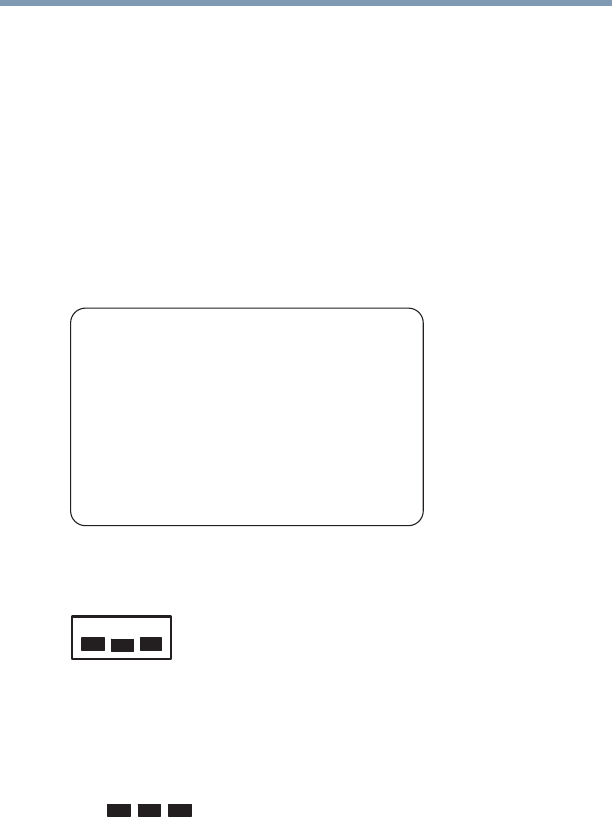
12
5.375 x 8.375 ver 2.3
Low power radio frequency electric machinery shall resist against interference
from legal communications or from industrial, scientific and medical radio
emission electric machinery.
Using this Equipment in Japan
In Japan, the frequency bandwidth of 2,400 MHz to 2,483.5 MHz for second
generation low-power data communication systems such as this equipment
overlaps that of mobile object identification systems (premises radio station and
specified low-power radio station).
1. Sticker
Please put the following sticker on devices incorporating this product.
2. Indication
The indication shown below appears on this equipment.
12.4: This equipment uses a frequency of 2.4 GHz.
2DS: This equipment uses DS-SS modulation.
OF: This equipment uses OFDM modulation.
3The interference range of this equipment is less than 40m.
4This equipment uses a frequency bandwidth from
2,400 MHz to 2,483.5 MHz.
It is possible to avoid the band of mobile object identification systems.
3. TOSHIBA Direct PC
Monday – Friday: 10:00 – 17:00
Toll Free Tel: 0120-15-1048
Direct Dial: 03-3457-4850
Fax: 03-3457-4868
The frequency bandwidth of this equipment may operate within the
same range as industrial devices, scientific devices, medical
devices, microwave ovens, licensed radio stations and non-licensed
specified low-power radio stations for mobile object identification
systems (RFID) used in factory product lines (Other Radio Stations).
1. Before using this equipment, ensure that it does not interfere with
any of the equipment listed above.
2. If this equipment causes RF interference to other radio stations,
promptly change the frequency being used, change the location
of use, or turn off the source of emissions.
3. Contact TOSHIBA Direct PC if you have problems with interference
caused by this product to Other Radio Stations.
2.4DSOF4
(1) (2) (3)
(4)
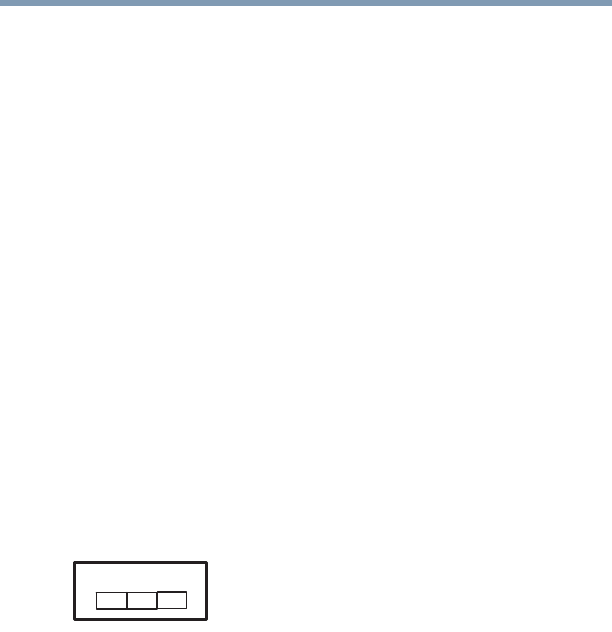
13
5.375 x 8.375 ver 2.3
Device Authorization
This device obtains the Technical Regulation Conformity Certification and the
Technical Conditions Compliance Approval, and it belongs to the device class of
radio equipment of low-power data communication system radio station
stipulated in the Radio Law and the Telecommunications Business Law of Japan.
The Name of the radio equipment: refer to the equipment label provided on the
computer
JAPAN APPROVALS INSTITUTE FOR TELECOMMUNICATIONS
EQUIPMENT
Approval Number: D01-1128JP
TELECOM ENGINEERING CENTER Approval Number: 03NY.A0018,
03GZDA0017
The following restrictions apply:
❖Do not disassemble or modify the device.
❖Do not install the embedded wireless module into other device.
❖5.17 GHz to 5.23 GHz for indoor use only.
2. Indication
The indication shown below appears on this equipment.
12.4: This equipment uses a frequency of 2.4 GHz.
2FH: This equipment uses FH-SS modulation.
3The interference range of this equipment is less than 10m.
4This equipment uses a frequency bandwidth from 2,400 MHz to
2,483.5 MHz. It is impossible to avoid the band of mobile object
identification systems.
3. TOSHIBA Direct PC
Monday – Friday: 10:00 – 17:00
Toll Free Tel: 0120-15-1048
Direct Dial: 03-3457-4850
Fax: 03-3457-4868
2.4FH1
(1) (2) (3)
(4)

14
5.375 x 8.375 ver 2.3
Device Authorization
This device obtains the Technical Regulation Conformity Certification, and it
belongs to the device class of radio equipment of low-power data communication
system radio station stipulated in the Radio Law of Japan.
The Name of the radio equipment: EYXF2CS
TELECOM ENGINEERING CENTER
Approval Number: 01NYDA1305
The following restrictions apply:
❖Do not disassemble or modify the device.
❖Do not install the embedded wireless module into other device.
Copyright
This guide is copyrighted by Toshiba America Information Systems, Inc. with all
rights reserved. Under the copyright laws, this guide cannot be reproduced in any
form without the prior written permission of Toshiba. No patent liability is
assumed, however, with respect to the use of the information contained herein.
©2008 by Toshiba America Information Systems, Inc. All rights reserved.
Export Administration Regulation
This document contains technical data that may be controlled under the U.S.
Export Administration Regulations, and may be subject to the approval of the
U.S. Department of Commerce prior to export. Any export, directly or indirectly,
in contravention of the U.S. Export Administration Regulations is prohibited.
Notice
The information contained in this manual, including but not limited to any
product specifications, is subject to change without notice.
TOSHIBA CORPORATION AND TOSHIBA AMERICA INFORMATION
SYSTEMS, INC. (TOSHIBA) PROVIDES NO WARRANTY WITH
REGARD TO THIS MANUAL OR ANY OTHER INFORMATION
CONTAINED HEREIN AND HEREBY EXPRESSLY DISCLAIMS ANY
IMPLIED WARRANTIES OF MERCHANTABILITY OR FITNESS FOR
ANY PARTICULAR PURPOSE WITH REGARD TO ANY OF THE
FOREGOING. TOSHIBA ASSUMES NO LIABILITY FOR ANY
DAMAGES INCURRED DIRECTLY OR INDIRECTLY FROM ANY
TECHNICAL OR TYPOGRAPHICAL ERRORS OR OMISSIONS
CONTAINED HEREIN OR FOR DISCREPANCIES BETWEEN THE
PRODUCT AND THE MANUAL. IN NO EVENT SHALL TOSHIBA BE
LIABLE FOR ANY INCIDENTAL, CONSEQUENTIAL, SPECIAL, OR
EXEMPLARY DAMAGES, WHETHER BASED ON TORT, CONTRACT

15
5.375 x 8.375 ver 2.3
OR OTHERWISE, ARISING OUT OF OR IN CONNECTION WITH THIS
MANUAL OR ANY OTHER INFORMATION CONTAINED HEREIN OR
THE USE THEREOF.
Trademarks
Microsoft, Outlook, and Windows are either registered trademarks or trademarks
of Microsoft Corporation in the United States and/or other countries.
ConfigFree is a registered trademark of Toshiba Corporation.
Wi-Fi is a registered trademark of the Wi-Fi Alliance.
Intel, Intel Core, Celeron, Centrino and Pentium are trademarks or registered
trademarks of Intel Corporation or its subsidiaries in the United States and other
countries.
TouchPad is a trademark of Synaptics, Inc.
Memory Stick and Memory Stick DUO are trademarks or registered trademarks
of Sony Corporation.
Secure Digital and SD are trademarks of SD Card Association.
MultiMediaCard and MMC are trademarks of MultiMediaCard Association.
Bluetooth word mark and logos are owned by the Bluetooth SIG, Inc. and any
use of such marks by Toshiba is under license. Other trademarks and trade names
are those of their respective owners.
All other brand and product names are trademarks or registered trademarks of
their respective companies.
Computer Disposal Information
Lamp contains mercury. Disposal of this product may be regulated due to
environmental considerations. For disposal, reuse or recycling information,
please contact your local government or the Electronic Industries Alliance at
www.eiae.org.
As part of Toshiba’s commitment to preserving the environment, Toshiba
supports various trade-in and recycling programs. Visit www.ToshibaDirect.com
and select Recycling & Trade-in Programs, or enter Recycle in the search bar.

16
5.375 x 8.375 ver 2.3
Contents
Introduction................................................................................ 20
This guide ...............................................................22
Safety icons ............................................................23
Other icons used...............................................23
Other documentation ..............................................24
Service options .......................................................24
Toshiba’s online resources .....................................24
Before you contact Toshiba ..............................24
Contacting Toshiba ...........................................25
Chapter 1: Getting Started......................................................... 26
Getting comfortable with your computer ................26
Keeping yourself comfortable ...........................27
Precautions.......................................................27
Important information on your computer’s
cooling fan..................................................28
Connecting to a power source ..........................29
Removing the battery from the computer ...............31
Inserting a charged battery .....................................32
Charging the main battery.................................33

17
Contents
5.375 x 8.375 ver 2.3
Charging the RTC battery..................................33
Monitoring main battery power...............................34
What to do when the main battery runs low .....36
Conserving battery power ................................36
Taking care of your battery .....................................36
Safety precautions ............................................36
Maintaining your battery...................................37
Disposing of used batteries ....................................38
Using the computer for the first time......................39
Opening the display panel.................................39
Turning on the power .......................................40
Using the TouchPad™.............................................40
Scrolling with the TouchPad™ ..........................41
Control buttons.................................................41
Using the keyboard.................................................41
Character keys .................................................42
Making your keyboard emulate a full-size
keyboard.....................................................42
Ctrl, Fn, and Alt keys.........................................42
Function keys....................................................42
Special Windows® keys ...................................43
Overlay keys .....................................................43
Using the overlay to type numeric data.............43
Setting up your computer .......................................44
Setting up your software...................................44
Registering your computer with Toshiba ................45
Adding optional external devices.............................45
Internal storage drive recovery using external
ODD/storage drive ............................................46
Creating Recovery DVD Media using an
external ODD drive......................................46
Internal Storage Drive using the
Recovery media ..........................................47

18 Contents
5.375 x 8.375 ver 2.3
Caring for your computer........................................48
Cleaning the computer......................................49
Moving the computer........................................49
Using a computer lock......................................49
Turning off the computer........................................50
Options for turning off the computer ................50
Closing the display panel ..................................52
Chapter 2: Features of Your Computer .................................... 53
Exploring the desktop .............................................53
Starting a program..................................................53
Setting up for communications...............................55
Connecting your computer to a network...........55
Exploring audio features .........................................56
Recording sounds.............................................56
Using external speakers or headphones............57
Web Camera ...........................................................57
Using the Bridge Media Adapter Slot ......................58
Inserting memory media...................................58
Removing memory media.................................59
Chapter 3: Hot Keys and Utilities..............................................60
Keyboard hot keys ..................................................60
Utilities....................................................................62
ConfigFree®.............................................................62
Getting Started........................................................63
Starting ConfigFree® ........................................63
ConfigFree® Utilities................................................64
Connectivity Doctor ..........................................64
Profile Settings .................................................65

19
Contents
5.375 x 8.375 ver 2.3
Chapter 4: If Something Goes Wrong ..................................... 68
Problems when you turn on the computer..............68
The Windows® operating system is not working ....70
Using Startup options to fix problems ..............70
Internet problems .............................................71
The Windows® operating system can help you .72
Wireless networking problems .........................72
Glossary...................................................................................... 75
Index............................................................................................ 89

20
Introduction
Welcome to the world of portable, multimedia computing. With
your Toshiba computer, your entertainment can accompany you
wherever you go. Using the installed wireless technology, you can
check email, enjoy streaming music or video, makes calls with
VOIP (Voice Over IP), or stay up-to-date with your favorite Web
pages.
Your Computer model may be ENERGY STAR® compliant. If the
model you purchased is compliant, it is labeled with the ENERGY
STAR® logo on the computer and the following information
applies.
Toshiba is a partner in the Environmental Protection Agency’s
(EPA) ENERGY STAR® Program and has designed this computer
to meet the latest ENERGY STAR® guidelines for energy
efficiency. Your computer ships with the power management
options preset to a configuration that will provide the most stable
operating environment and optimum system performance for both
AC power and battery modes.
To conserve energy, your computer is set to enter the low-power
Standby mode which shuts down the system and display within 15
minutes of inactivity in AC power mode. We recommend that you
leave this and other energy saving features active, so that your
computer will operate at its maximum energy efficiency. You can
wake the computer from Standby mode by pressing the power
button.

21
Introduction
5.375 x 8.375 ver 2.3
According to the EPA, a computer meeting the new ENERGY
STAR® specifications will use between 20% and 50% less energy
depending on how it is used. If all U.S. household and businesses
replaced old computers with new ENERGY STAR® qualified
models, we would save more than $1.8 billion in energy costs over
the next five years and avoid greenhouse gas emissions equivalent
to more than 2.7 million cars.
If every computer purchased by businesses next year met the new
ENERGY STAR® requirements, businesses would save more than
$210 million over the lifetime of those models. That is equivalent to
lighting 120 million square feet of U.S. commercial building space
each year.
During 2006 Americans, with the help of ENERGY STAR®, saved
about $14 billion dollars on their utility bills and avoided
greenhouse gas emissions equivalent to those from 25 million
vehicles.
Visit http://www.energystar.gov or
http://www.energystar.gov/powermanagement for more
information regarding the ENERGY STAR® Program.
This computer is compatible with European Union Directive
2002/95/EC, Restriction of the use of certain Hazardous Substances
in electrical and electronic equipment (RoHS), which restricts use of
lead, cadmium, mercury, hexavalent chromium, PBB, and PBDE.
Toshiba requires its computer component suppliers to meet RoHS
requirements and verifies its suppliers’ commitment to meeting
RoHS requirements by conducting component sampling inspections
during the product design approval process.
Certain Microsoft® software product(s) included with this computer
may use technological measures for copy protection. IN SUCH EVENT,
YOU WILL NOT BE ABLE TO USE THE PRODUCT IF YOU DO NOT
FULLY COMPLY WITH THE PRODUCT ACTIVATION PROCEDURES.
Product activation procedures and Microsoft’s privacy policy will be
detailed during initial launch of the product, or upon certain
reinstallations of the software product(s) or reconfigurations of the
computer, and may be completed by Internet or telephone (toll charges
may apply).
Some software may differ from its retail version (if available), and may
not include user manuals or all program functionality.
NOTE
NOTE

22 Introduction
This guide
5.375 x 8.375 ver 2.3
The product specifications and configuration information are designed
for a product Series. Your particular model may not have all the features
and specifications listed or illustrated. For more detailed information
about the features and specifications on your particular model, please
visit Toshiba’s Web site at pcsupport.toshiba.com.
While Toshiba has made every effort at the time of publication to ensure
the accuracy of the information provided herein, product specifications,
configurations, prices, system/component/options availability are all
subject to change without notice. For the most up-to-date product
information about your computer, or to stay current with the various
computer software or hardware options, visit Toshiba’s Web site at
pcsupport.toshiba.com.
This guide
This guide introduces the computer’s features. You can:
❖Read the entire guide from beginning to end.
❖Skim through and stop when a topic interests you.
❖Use the table of contents and the index to find specific
information.
NOTE
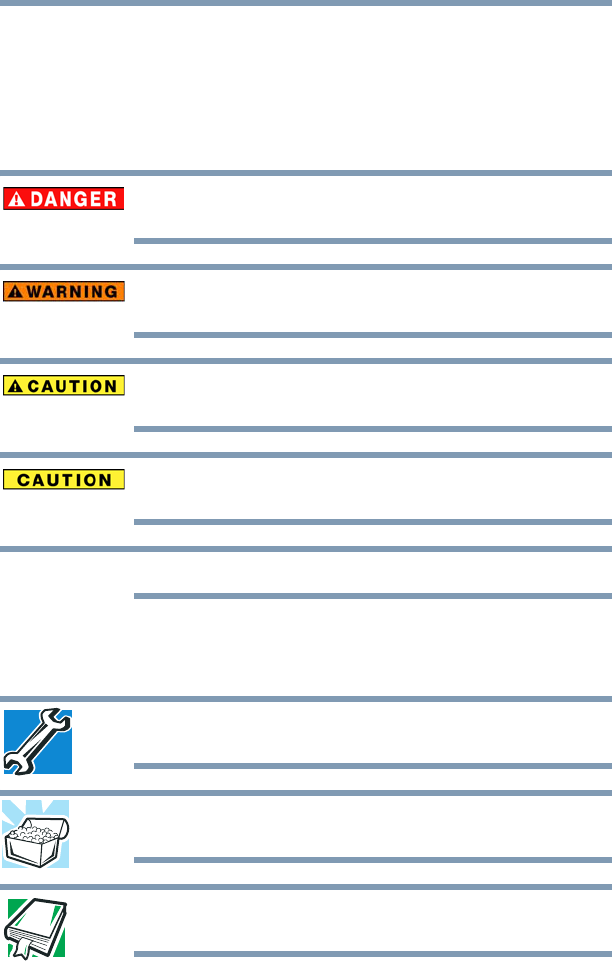
23
Introduction
Safety icons
5.375 x 8.375 ver 2.3
Safety icons
This manual contains safety instructions that must be observed to
avoid potential hazards that could result in personal injuries,
damage to your equipment, or loss of data. These safety cautions
have been classified according to the seriousness of the risk, and
icons highlight these instructions as follows:
Indicates an imminently hazardous situation which, if not avoided,
will result in death or serious injury.
Indicates a potentially hazardous situation which, if not avoided,
could result in death or serious injury.
Indicates a potentially hazardous situation which, if not avoided, may
result in minor or moderate injury.
Indicates a potentially hazardous situation which, if not avoided, may
result in property damage.
Provides important information.
Other icons used
Additional icons highlight other helpful or educational information:
TECHNICAL NOTE: This icon indicates technical information about
the computer.
HINT: This icon indicates helpful hints and tips.
DEFINITION: This icon indicates the definition of a term used in the
text.
NOTE

24 Introduction
Other documentation
5.375 x 8.375 ver 2.3
Other documentation
Your computer comes with the following documentation:
❖An electronic version of the user’s guide (this document)
❖It may also contain guides for other programs that may come
with your system.
For accessory information, visit Toshiba’s Web site at
accessories.toshiba.com.
Service options
Toshiba offers a full line of optional service programs to
complement its standard limited warranty. Toshiba’s standard
limited warranty, extended warranty, and service upgrade terms and
conditions are available at warranty.toshiba.com.
To stay current on the most recent software and hardware options
for your computer, and for other product information, be sure to
regularly check the Toshiba Web site at pcsupport.toshiba.com.
Toshiba’s online resources
Toshiba maintains a number of online sites to which you can
connect. These sites provide information about Toshiba products,
give help with technical questions and keep you up to date with
future upgrades.
Before you contact Toshiba
Since some problems may be related to the operating system or the
program you are using, it is important to investigate other sources
of assistance first.
Try the following before you contact Toshiba:
❖Review the troubleshooting information in your operating
system documentation.
❖If the problem occurs while you are running a program, consult
the program’s documentation for troubleshooting suggestions.
Contact the software company’s technical support group for
their assistance.
For the number of a Toshiba dealer near you, see “Toshiba voice
contact” in this section.

25
Introduction
Toshiba’s online resources
5.375 x 8.375 ver 2.3
Contacting Toshiba
If you still need help and suspect that the problem is hardware-
related, Toshiba offers a variety of resources to help you.
Toshiba’s Technical Support Web site
For technical support, or to stay current on the most recent software
and hardware options for your computer, and for other product
information, be sure to regularly check the Toshiba Web site at
pcsupport.toshiba.com.
Toshiba voice contact
Before calling Toshiba, make sure you have:
❖Your computer’s serial number
❖The computer and any optional devices related to the problem
❖Backup copies of your Windows® operating system and all
other preloaded software on your choice of media
❖Name and version of the program involved in the problem
along with its installation media
❖Information about what you were doing when the problem
occurred
❖Exact error messages and when they occurred
For technical support, call the Toshiba Customer Support Center:
Within the United States at (800) 457-7777
Outside the United States at (949) 859-4273

26
Chapter 1
Getting Started
This chapter provides tips for using your computer effectively,
summarizes how to connect components, and explains what to do
the first time you use your computer.
The “Instruction Manual for Safety and Comfort,” that is shipped
with your computer, contains important safety information. Please
read the safety instructions carefully and make sure you fully
understand the instructions before you attempt to use your
computer in order to avoid potential hazards that could cause bodily
injury, property damage, or damage the computer.
Getting comfortable with your computer
Place the computer on a hard flat surface that is large enough for the
computer and any other items you are using, such as a printer.
Leave enough space around the computer and other equipment to
provide adequate ventilation. Otherwise, they may overheat. Read
the “Provide adequate ventilation” section in the “Instruction
Manual for Safety and Comfort” that is shipped with your
computer.
To keep your computer in prime operating condition, protect your
work area from:
❖Dust, moisture, and direct sunlight.
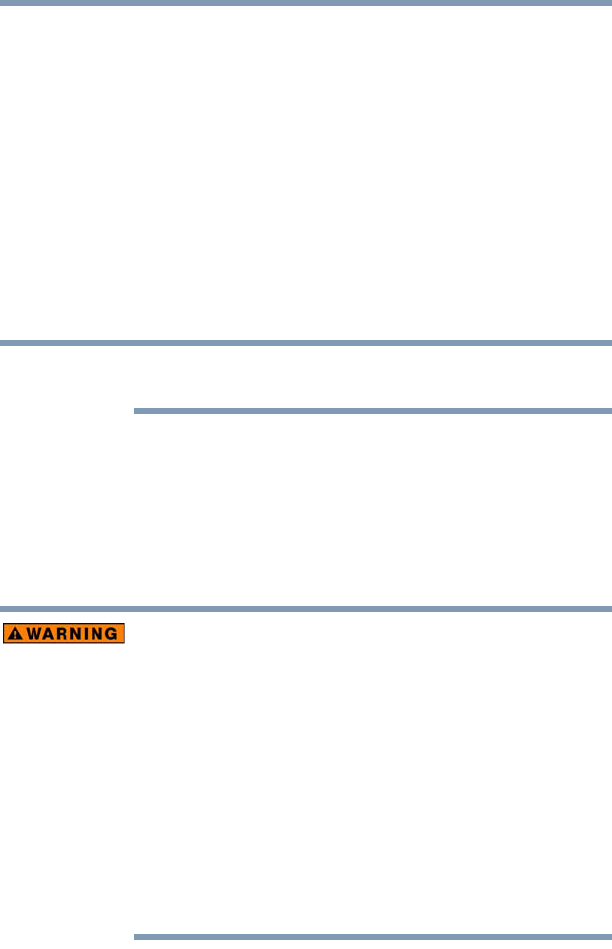
27
Getting Started
Getting comfortable with your computer
❖Equipment that generates a strong electromagnetic field, such
as stereo speakers (other than speakers that are connected to
the computer) or speakerphones.
❖Rapid changes in temperature or humidity and sources of
temperature change such as air conditioner vents or heaters.
❖Extreme heat, cold, or humidity.
❖Liquids and corrosive chemicals.
Keeping yourself comfortable
The Toshiba Instruction Manual for Safety and Comfort, that
shipped with your computer, contains helpful information for
setting up your work environment and tips for working comfortably
throughout the day.
Please handle your computer carefully to avoid scratching or
damaging the surface.
Precautions
Your computer is designed to provide optimum safety and ease of
use, and to withstand the rigors of travel. You should observe
certain precautions to further reduce the risk of personal injury or
damage to the computer.
❖Avoid prolonged physical contact with the underside or surface
of the computer.
Never allow any liquids to spill into any part of your computer, and
never expose the computer to rain, water, seawater or moisture.
Exposure to liquid or moisture can cause electric shock or fire,
resulting in damage or serious injury. If any of these eventualities
should accidentally occur, immediately:
1. Turn off the computer.
2. Disconnect the AC adaptor from the power plug socket and
computer.
3. Remove the battery pack.
Failure to follow these instructions could result in serious injury or
permanent damage to the computer.
Do not turn on the power again until you have taken the computer to
an authorized service center.
NOTE
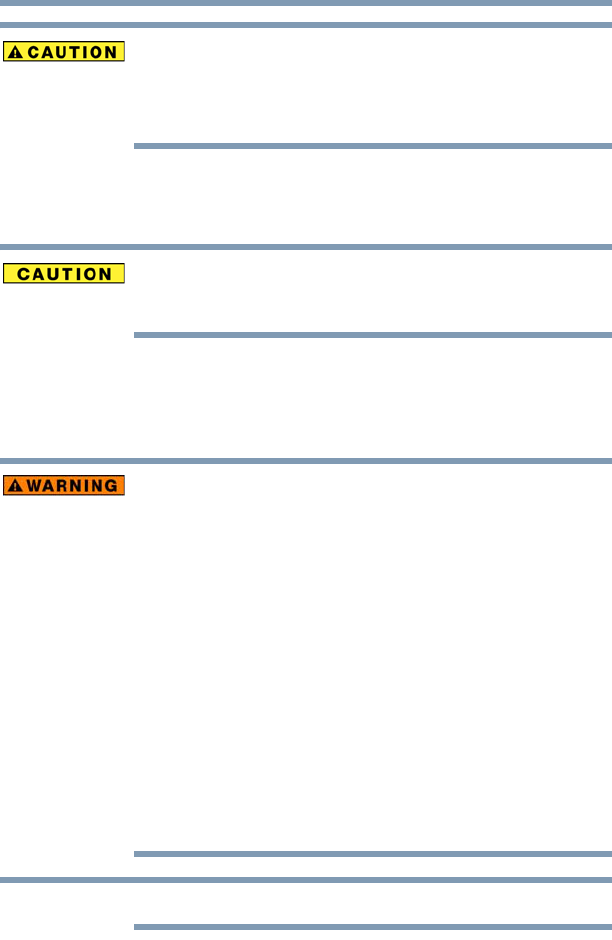
28 Getting Started
Getting comfortable with your computer
❖ Avoid prolonged physical contact with the underside or surface
of the computer.
❖ Computer base and palm rest can become hot! Avoid prolonged
contact to prevent heat injury to skin.
Read the “Avoid extended contact between computer base/palm rest
and skin” section in the “Instruction Manual for Safety and
Comfort” that is shipped with your computer.
Never place a heavy object on the computer and be careful not to
drop a heavy object onto the computer. It could damage the
computer or cause system failure.
Important information on your computer’s cooling fan
Your computer may have a CPU cooling fan that cools the CPU by
drawing outside air into the computer.
Always make sure your computer and AC adaptor have adequate
ventilation and are protected from overheating when the power is turned
on or when an AC adaptor is connected to a power outlet (even if your
computer is in Standby mode). In this condition, observe the following:
❖ Never cover your computer or AC adaptor with any object.
❖ Never place your computer or AC adaptor near a heat source,
such as an electric blanket or heater.
❖ Never cover or block the air vents including those located at the
base of the computer.
❖ Always operate your computer on a hard flat surface. Using your
computer on a carpet or other soft material can block the vents
located at the base of the computer.
Overheating your computer or AC adaptor could cause system
failure, computer or AC adaptor damage or a fire, possibly resulting
in serious injury.
The cooling fan location will vary depending on the computer.
NOTE
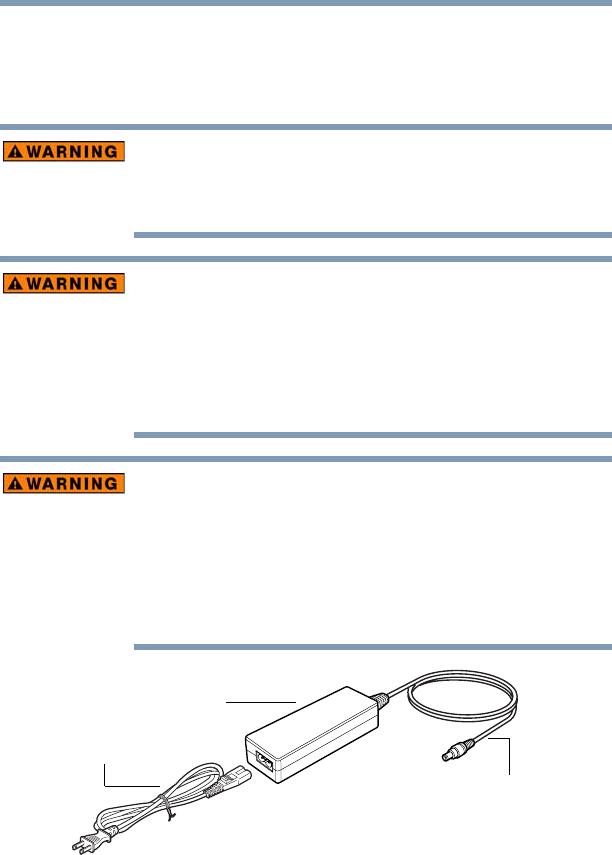
29
Getting Started
Getting comfortable with your computer
Connecting to a power source
Your computer requires power to operate. Use the power cord/cable
and AC adaptor to connect the computer to a live electrical outlet,
or to charge the computer’s battery.
Never pull on a power cord/cable to remove a plug from a socket.
Always grasp the plug directly. Failure to follow this instruction may
damage the cord/cable, and/or result in a fire or electric shock,
possibly resulting in serious injury.
Always confirm that the power plug (and extension cable plug if
used) has been fully inserted into the socket, to ensure a secure
electrical connection. Failure to do so may result in a fire or electric
shock, possibly resulting in serious injury.
Be careful if you use a multiple connector. An overload on one socket
could cause a fire or electric shock, possibly resulting in serious
injury.
Always use the TOSHIBA AC adaptor that was provided with your
computer and the TOSHIBA Battery Charger (that may have been
provided with your computer), or use AC adaptors and battery
chargers specified by TOSHIBA to avoid any risk of fire or other
damage to the computer. Use of an incompatible AC adaptor or
Battery Charger could cause fire or damage to the computer, possibly
resulting in serious injury. TOSHIBA assumes no liability for any
damage caused by use of an incompatible adaptor or charger.
(Sample Illustration) Power cord/cable and AC adaptor
AC adaptor
Power cord/cable
AC adaptor cord
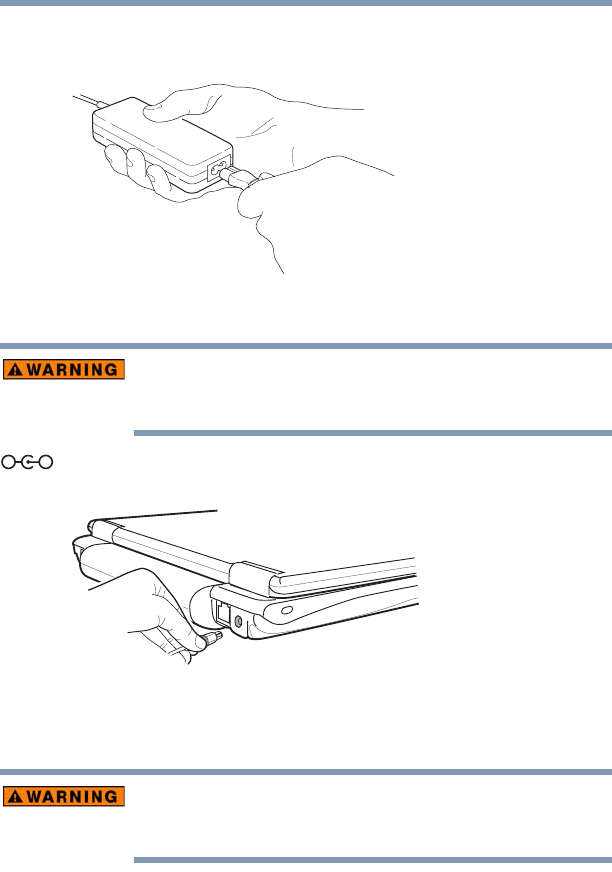
30 Getting Started
Getting comfortable with your computer
To connect AC power to the computer:
1Connect the power cord/cable to the AC adaptor.
(Sample Illustration) Connecting the power cord/cable to the AC
adaptor
Handling the cord on this product will expose you to lead, a
chemical known to the State of California to cause birth defects or
other reproductive harm. Wash hands after handling.
2Plug the AC adaptor cord into the DC-IN on the back of the
computer.
(Sample Illustration) Connecting the AC adaptor cord to the
computer
3Connect the power cord/cable to a live electrical outlet.
Never attempt to connect or disconnect a power plug with wet hands.
Failure to follow this instruction could result in an electric shock,
possibly resulting in serious injury.
_
+
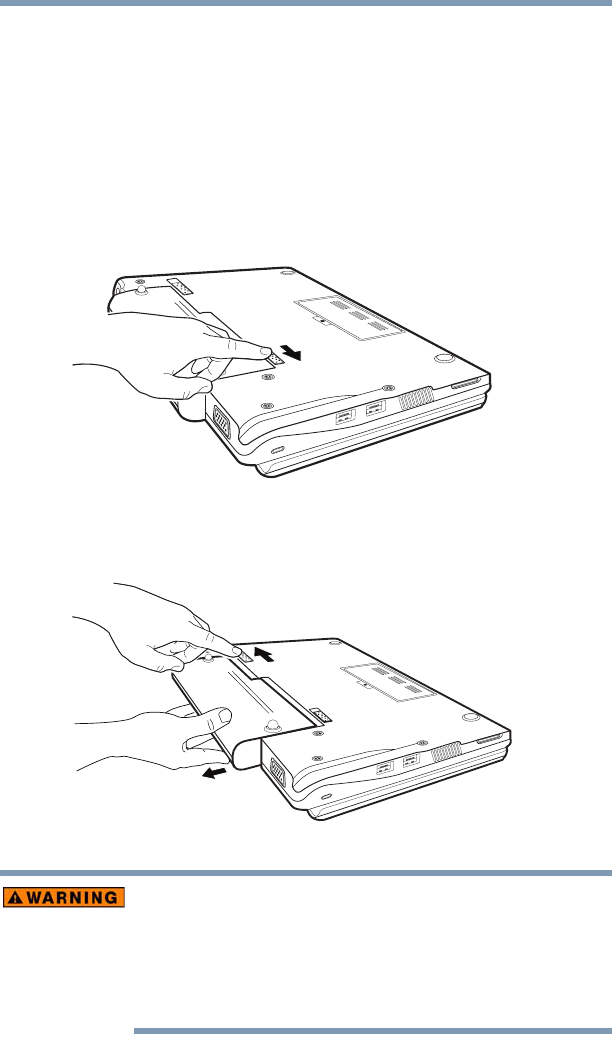
31
Getting Started
Removing the battery from the computer
Removing the battery from the computer
To remove the battery:
1Save your work.
2Turn off the computer or place it in Hibernation mode.
3Unplug and remove any cables connected to the computer,
including the AC adaptor.
4Close the display panel and turn the computer upside down.
5Slide the battery release lock to the unlocked position.
(Sample Illustration) Unlocking the battery release lock
6Slide the battery release latch to release the battery.
7Pull the discharged battery out of the computer.
(Sample Illustration) Removing the battery
If the battery is leaking or its case is cracked, put on protective gloves
to handle it, and discard it immediately. Always dispose of used battery
packs in compliance with all applicable laws and regulations. Put
insulating tape, such as cellophane tape, on the electrode during
transportation to avoid a possible short circuit, fire or electric shock.
Failure to do so could possibly result in serious injury.
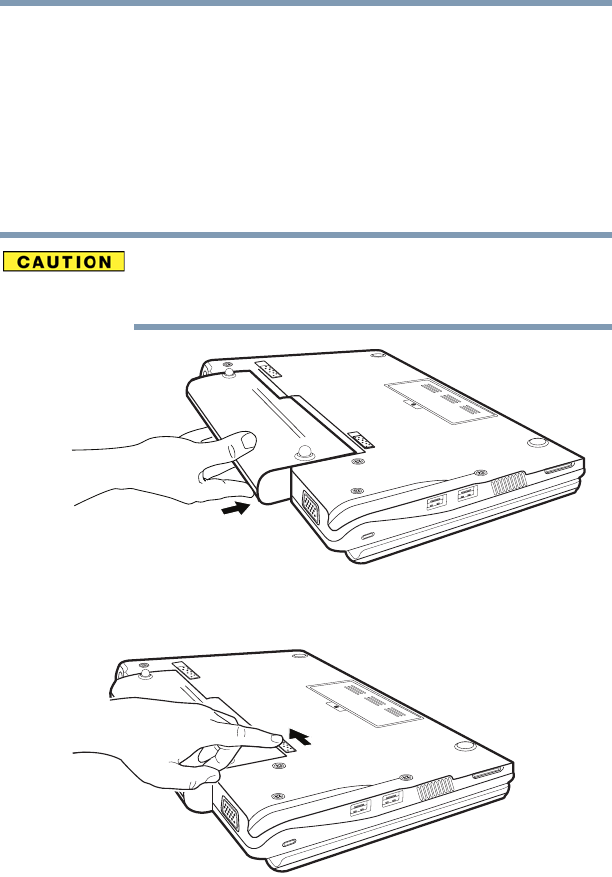
32 Getting Started
Inserting a charged battery
Inserting a charged battery
To insert a battery:
1Wipe the terminals of the charged battery with a clean cloth to
ensure a good connection.
2Insert the charged battery into the slot until the latch clicks.
The battery pack has been designed so that you cannot install it
with reverse polarity.
If the battery does not slide into the slot easily, move the battery
release lock to the unlocked position and try again. Do not force the
battery into position.
(Sample Illustration) Inserting the battery
3Slide the battery release lock to the locked position.
(Sample Illustration) Locking the battery release lock
4Turn the computer right side up.
5Reconnect any cables that were removed in step 3 of
“Removing the battery from the computer” on page 31.
6Restart the computer.
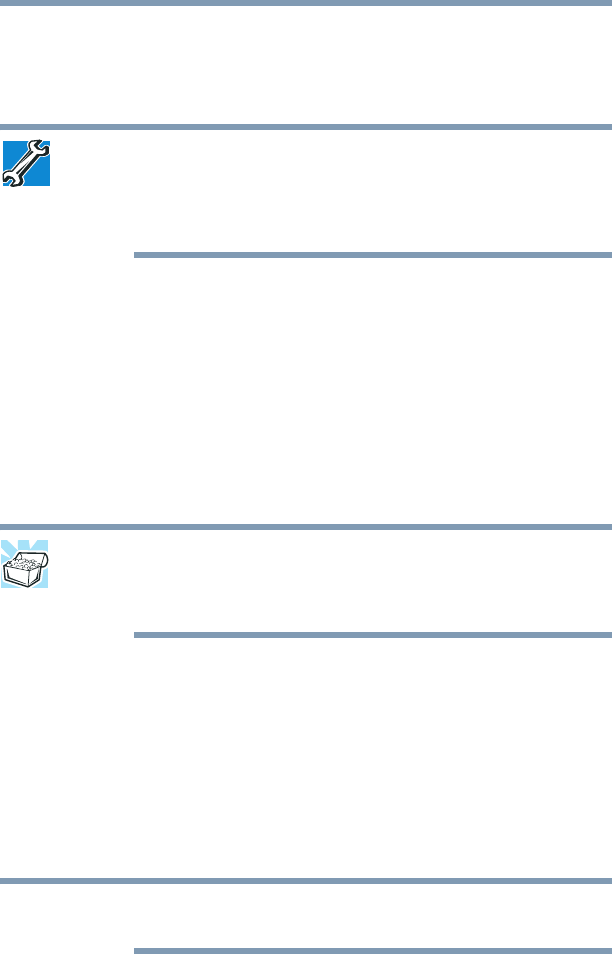
33
Getting Started
Inserting a charged battery
Charging the main battery
To charge the main battery while it is in your computer, plug the
computer into a live electrical outlet. The battery charges whether
the computer is on or off.
TECHNICAL NOTE: The recharging of the battery cannot occur when
your computer is using all of the power provided by the AC adaptor to
run applications, features, and devices. Your computer's Power Options
utility can be used to select a power level setting that reduces the power
required for system operation and will allow the battery to recharge.
The battery may not start charging immediately under the following
conditions:
❖The battery is extremely hot or cold.
To ensure that the battery charges to its full capacity, wait until
it reaches room temperature (50 to 80 degrees Fahrenheit, 10 to
26 degrees Celsius).
❖The battery is almost completely discharged.
Leave the power connected and the battery should begin
charging after a few minutes.
HINT: Once the battery is fully charged, we recommend that you
operate your computer on battery power until the battery discharges
completely. Doing this extends battery life and helps ensure accurate
monitoring of battery capacity.
Charging the RTC battery
Your computer has an internal real-time clock (RTC) battery. The
RTC battery powers the System Time Clock and BIOS memory
used to store your computer’s configuration settings. When fully
charged, it maintains this information for up to a month when the
computer is powered off.
The RTC battery may have become completely discharged while
your computer was shipped, resulting in a CMOS error message
during startup. The error message may vary by computer model.
Depending on your system, the RTC battery may only charge while
the computer is turned on.
To recharge the RTC battery, plug the computer into a live electrical
outlet and leave the computer powered on for 24 hours.
NOTE
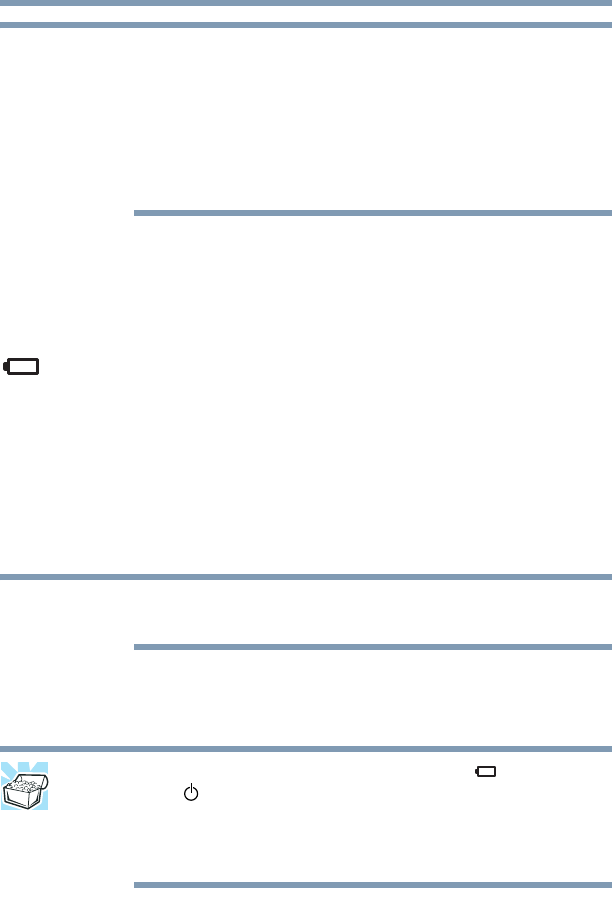
34 Getting Started
Monitoring main battery power
It is seldom necessary to charge the RTC battery because it charges
while the computer is on. If the RTC battery is low, the real-time
clock and calendar may display the incorrect time and date or stop
working.
When Hibernation mode is enabled and the RTC battery is
completely discharged, a warning prompts you to reset the real-time
clock.
The computer can be used while the RTC battery is being charged,
although the charging status of the RTC battery cannot be
monitored.
Monitoring main battery power
The computer’s main battery light gives you an indication of the
main battery’s current charge:
❖Slowly blinks green while the main battery is being charged
(AC adaptor connected).
❖Glows green when the main battery is fully charged and the AC
adaptor is not connected to the computer.
❖Is unlit when the main battery is fully charged and the AC
adaptor is plugged into the computer and an AC outlet.
Battery life and charge time may vary, depending upon power
management settings, applications and features used.
❖Rapidly blinks green when the main battery charge is low and
it is time to recharge the main battery or plug in the AC
adaptor.
HINT: Be careful not to confuse the battery light () with the on/off
light ().
When the on/off light flashes green, it indicates that the system is
suspended (using the Windows® operating system Standby
command).
NOTE
NOTE
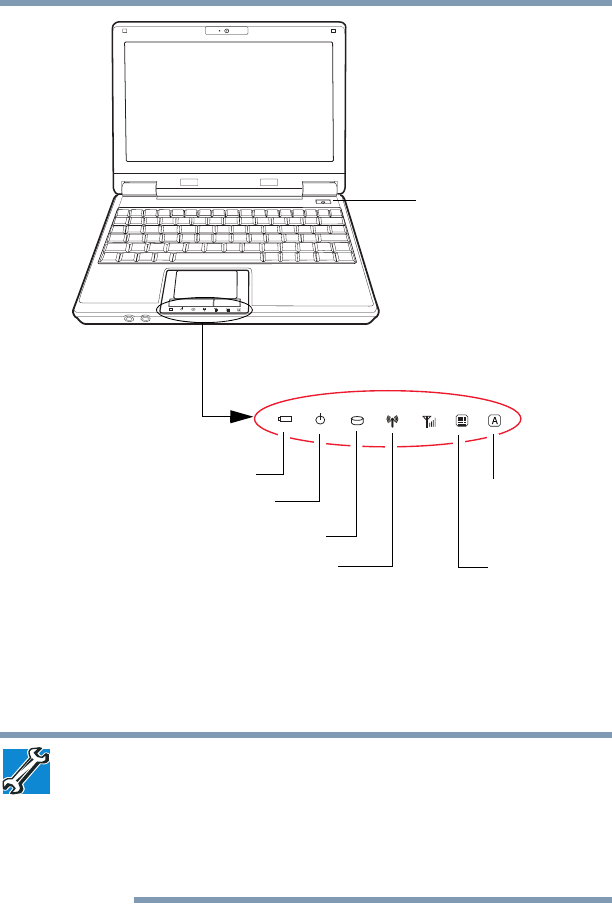
35
Getting Started
Monitoring main battery power
(Sample Illustration) Power and battery light locations
With repeated discharges and recharges, the battery’s capacity
gradually decreases. A frequently used older battery does not
power the computer for as long as a new battery, even when
both are fully charged.
TECHNICAL NOTE: The computer drains the battery faster at low
temperatures. Check your remaining charge frequently if you are
working in temperatures below 50 degrees Fahrenheit.
The computer calculates the remaining battery charge based on your
current rate of power use and other factors such as the age of the
battery.
Power button
System indicator lights
Internal storage drive light
On/off light
Battery light
Wireless indicator light
Caps lock light
Numlock light

36 Getting Started
Taking care of your battery
What to do when the main battery runs low
When the main battery runs low you can:
❖Plug the computer into an external power source and recharge
the main battery
❖Place the computer into Hibernation mode and replace the
main battery with a charged spare (not included with your
computer)
❖Save your work and turn off the computer
Conserving battery power
How long a fully charged battery pack lasts when you are using the
computer depends on a number of factors, such as:
❖How the computer is configured
❖How much you use the internal storage drive or other optional
devices
❖Where you are working, since operating time decreases at low
temperatures
You can also conserve power and extend the operating time of your
battery by enabling Standby or Hibernation mode, which saves
power when you turn off the computer and turn it back on again.
Taking care of your battery
The following sections offer tips on how to take care of your battery
and prolong its life.
Safety precautions
❖If the battery pack produces an odor, overheats or changes
color or shape while it is being used or charged, turn off the
computer’s power immediately and disconnect the power
cord/cable from the power socket. Carefully remove the battery
pack from the computer.
❖Do not try to disassemble a battery pack.
❖Do not overcharge or reverse charge a battery. Overcharging
will shorten its life, and reverse charging could damage it.
❖Avoid touching the metal terminals of the battery with another
metal object. Short-circuiting the battery can cause it to
overheat and may cause damage to the battery or the computer.
❖Do not incinerate a spent battery, as this could cause it to
explode and release caustic liquid.
❖If a battery is leaking or damaged, replace it immediately. Use
protective gloves when handling a damaged battery.

37
Getting Started
Taking care of your battery
❖To replace the main battery, use an identical battery that you
can purchase through the Toshiba Web site at
accessories.toshiba.com.
❖A reverse polarity condition should be avoided with all
batteries. The main battery is designed so that it cannot be
installed in reverse polarity.
❖Charge the battery only in the computer or in a battery charger
designated as an approved option.
❖When you install the battery pack, you should hear a click
when it is seated properly.
❖Do not expose the battery pack to fire. The battery pack could
explode.
Maintaining your battery
Fully discharging your battery pack will allow better accuracy of
the battery meter.
To fully discharge your battery pack:
❖Periodically, disconnect the computer from a power source and
operate it on battery power until the battery pack fully
discharges. Before doing so, follow the steps below:
1Turn off the computer’s power.
2Disconnect the AC adaptor and turn on the computer’s
power. If it does not turn on, go to step 4.
3Operate the computer on battery power for five minutes. If
the battery pack has at least five minutes of operating time,
continue operating until the battery pack is fully
discharged. If the battery light blinks rapidly, indicating a
low battery, go to step 4.
4Connect the AC adaptor to the computer and the power
cord/cable to a power outlet. The battery light should blink
slowly to indicate that the battery pack is being charged.
5Charge the battery pack until the battery light turns off.
❖If you have extra battery packs, rotate their use.
❖If you will not be using the system for an extended period,
more than one month, remove the battery pack.
❖If you are not going to use the computer for more than eight
hours, disconnect the AC adaptor.
❖Store spare battery packs in a cool dry place out of direct
sunlight.
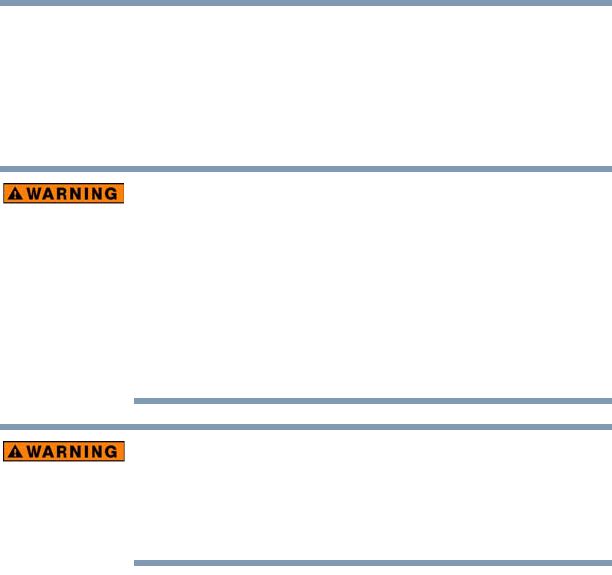
38 Getting Started
Disposing of used batteries
Disposing of used batteries
The life of a battery pack depends on usage. When the battery pack
needs replacing, the main battery light blinks rapidly shortly after
you have fully recharged the battery.
You must discard a battery if it becomes damaged.
Never attempt to dispose of a battery pack by burning or by throwing
it into a fire, and never allow exposure to a heating apparatus (e.g.,
microwave oven). Heat can cause a battery pack to explode and/or
release caustic liquid, both which may possibly cause serious injury.
Always dispose of used battery packs in compliance with all
applicable laws and regulations. Put insulating tape, such as
cellophane tape, on the electrode during transportation to avoid a
possible short circuit, fire or electric shock. Failure to do so could
possibly result in serious injury.
Always use the battery pack supplied as an accessory or an
equivalent battery pack specified in the User's Manual. Other battery
packs have different voltage and terminal polarities. Use of non-
conforming battery packs could generate smoke or cause fire or
rupture, possibly resulting in serious injury.
After repeated use, the batteries will finally lose their ability to hold
a charge and you will need to replace them. Under certain
applicable laws and regulations, it may be illegal to dispose of old
batteries by placing them in the trash.
Please be kind to our shared environment. Check with your local
government authority for details regarding where to recycle old
batteries or how to dispose of them properly. If you cannot find the
information you need elsewhere, call Toshiba at: (800) 457-7777.
In addition, Toshiba’s recycling initiatives include recycling
programs, events and consumer promotions. For details, visit
www.ToshibaDirect.com, select Recycling & Trade-in programs, or
enter Recycle in the search bar.
Toshiba is dedicated to preserving the environment by sponsoring
Call2Recycle™, a program of the Rechargeable Battery Recycling
Corporation. For more information and for drop-off locations, visit
www.rbrc.org or call 1-800-822-8837.
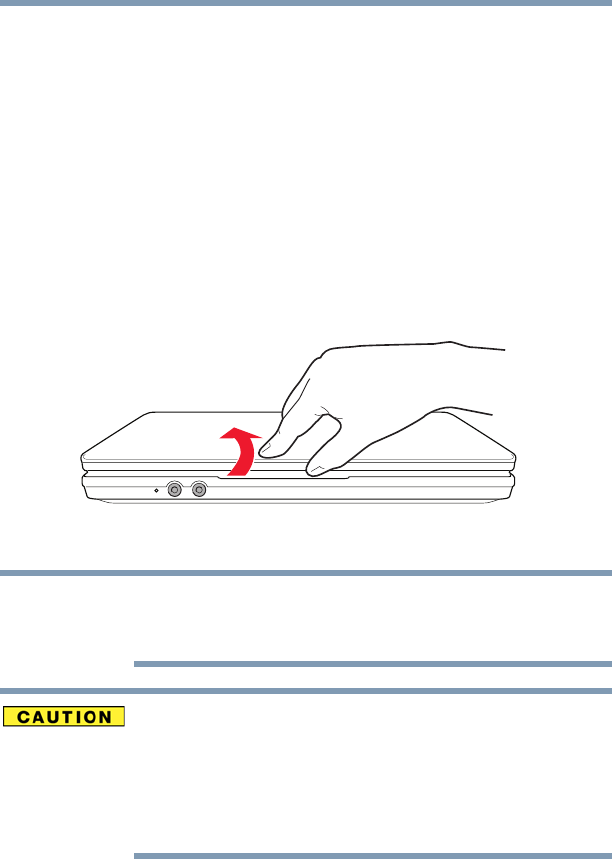
39
Getting Started
Using the computer for the first time
Notice regarding CR coin cell batteries, applicable to California,
U.S.A. only:
Perchlorate Material - special handling may apply.
See http://www.dtsc.ca.gov/hazardouswaste/perchlorate/
Using the computer for the first time
The computer is now ready for you to turn it on and begin using it.
Opening the display panel
1Facing the front of the computer, locate the center of the
display panel.
2Gently raise the panel.
3Adjust the display to a comfortable viewing angle.
(Sample Illustration) Opening the display panel
When opening or closing the display panel, place one hand on the
palm rest to hold the computer in place and use the other hand to
slowly open or close the display panel.
To avoid damaging the display panel, do not force it beyond the point
where it moves easily and never lift the computer by the display
panel.
Do not press or push on the display panel and be careful to remove
any pens or other objects from the keyboard area before closing the
display panel.
Small bright dots may appear on your screen display when you turn
on your computer. Your display contains an extremely large number
of thin-film transistors (TFT) and is manufactured using high-
precision technology. Any small bright dots that may appear on
your display are an intrinsic characteristic of the TFT
manufacturing technology. Over a period of time, and depending on
the usage of the computer, the brightness of the screen will
NOTE
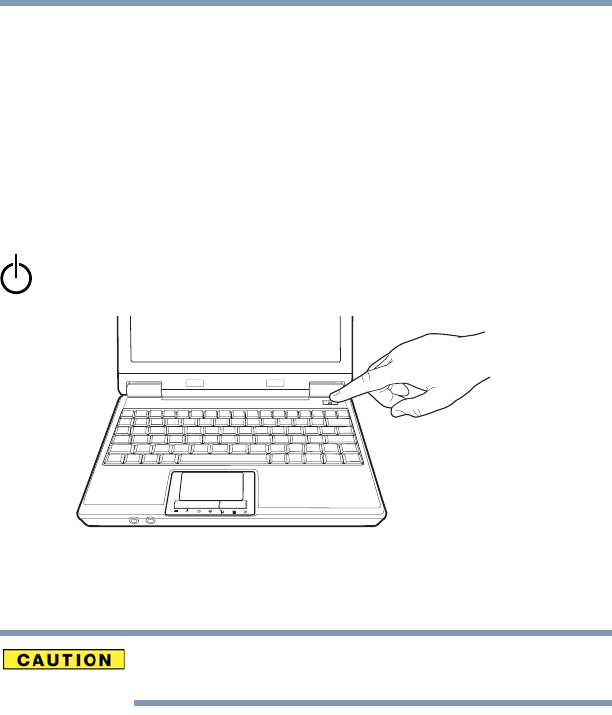
40 Getting Started
Using the TouchPad™
deteriorate. This is also an intrinsic characteristic of the screen
technology. When the computer is operated on battery power, the
screen will dim and you may not be able to increase the brightness
of the screen while on battery power.
Turning on the power
To turn on the computer:
1Make sure any external devices (such as the AC adaptor, if you
plan to use AC power rather than battery power) are properly
connected and ready.
2Press and release the power button. The on/off light glows
green.
(Sample Illustration) Turning on the power
The preinstalled operating system will load automatically.
When you turn on the computer for the first time, do not turn off the
power again until the operating system has loaded completely.
Using the TouchPad™
The TouchPad™, the small, rectangular area located in front of the
keyboard, is sensitive to touch and enables you to move the cursor
with the stroke of a finger. Simply move your finger on the
TouchPad in the direction you would like to move the cursor:
❖To move the cursor to the top of the page, push your finger
forward on the TouchPad.
❖To move the cursor to the bottom of the page, drag your finger
toward yourself.
❖To move the cursor to the right side of the page, slide your
finger across the TouchPad from left to right.
❖To move it to the left side, slide your finger from right to left.
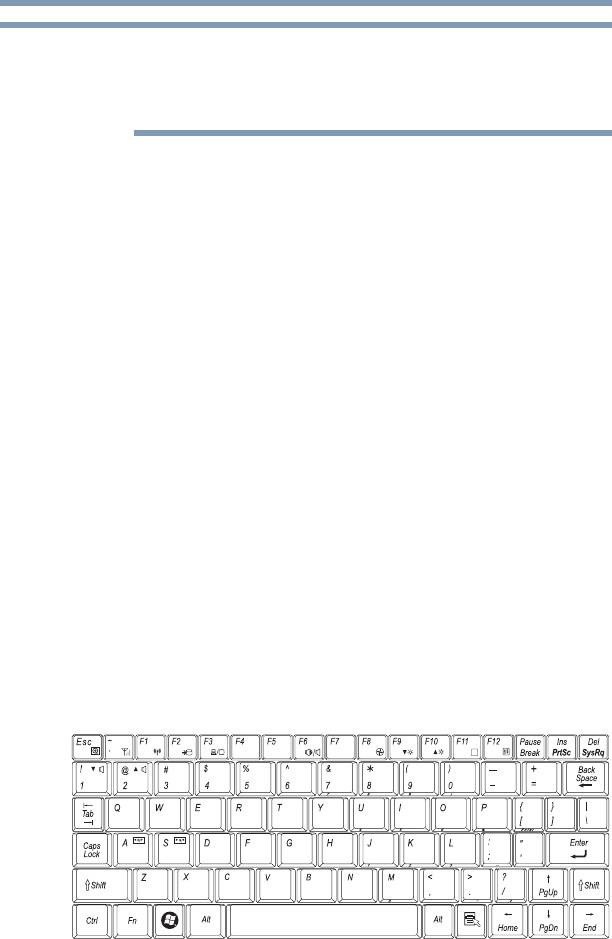
41
Getting Started
Using the keyboard
Because the TouchPad is much smaller than the display screen,
moving your cursor across the screen often means having to move
your finger several times across the TouchPad in the preferred
direction.
Once you have positioned your cursor, you can click it into place by
either double-tapping the TouchPad or clicking the control buttons.
Scrolling with the TouchPad™
There are two active regions on the TouchPad™ that allow you to
scroll as you would with any wheel device on a mouse or trackball.
To scroll vertically, run your finger up or down along the right edge
of the TouchPad. To scroll horizontally, run your finger along the
bottom edge of the TouchPad. This feature can be disabled or
changed in the Mouse Properties dialog box.
Control buttons
When a step instructs you to click or choose an item, move the
cursor to the item, then press and release the primary (left-hand)
button. To double-click, press the primary button twice in rapid
succession. The primary button usually corresponds to the left
mouse button.
The function of the secondary (right-hand) button depends on the
program you are using. It usually corresponds to the right mouse
button (“right-clicking”). Check your program’s documentation to
determine whether it uses the right mouse button.
Using the keyboard
Your computer’s keyboard contains character keys, control keys,
function keys, and special Windows® keys, providing all the
functionality of a full-size keyboard.
(Sample Illustration) Keyboard
NOTE
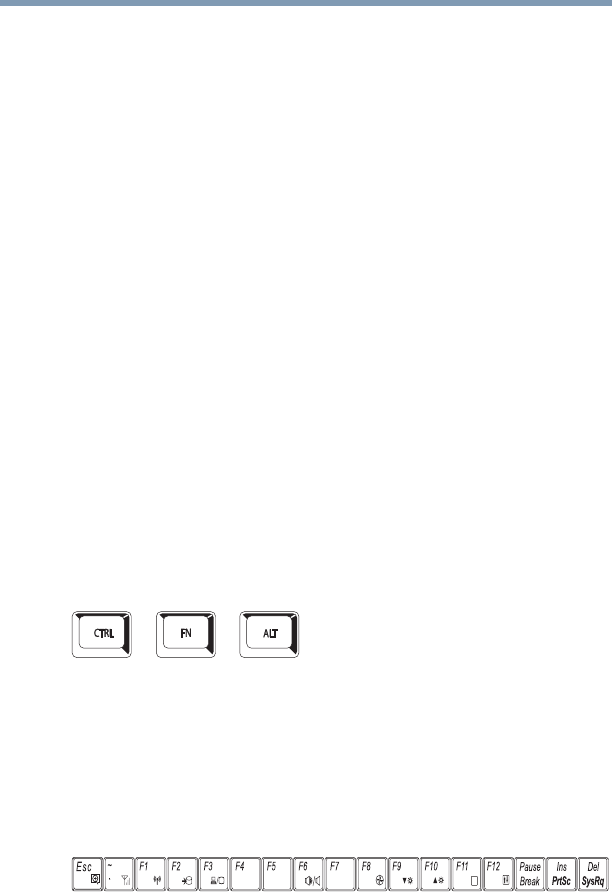
42 Getting Started
Using the keyboard
Character keys
Typing with the character keys is very much like typing on a
typewriter, except that:
❖The space bar creates a space character instead of just passing
over an area of the page.
❖The lowercase letter l (el) and the number 1 are not
interchangeable.
❖The uppercase letter O and the number 0 are not
interchangeable.
Making your keyboard emulate a full-size keyboard
Although your computer’s keyboard layout is compatible with a
standard full-size keyboard, it includes fewer keys.
A standard full-size keyboard includes two Enter, Ctrl, and Alt keys;
editing keys; cursor positioning keys; and a numeric keypad.
Your computer’s keyboard includes only one Enter and one Ctrl key.
Most of the time, this does not matter. However, some programs
assign separate functions to the regular and numeric pad Enter keys
on the full-sized keyboard. Using the Fn key, you can simulate the
Enter key. Press Fn and Enter simultaneously to simulate the Enter key
on the numeric pad of the enhanced keyboard. Pressing the Fn key
simultaneously in combination with one of the specially marked
keys allows you to emulate a full-size keyboard.
Ctrl, Fn, and Alt keys
(Sample Illustration) Ctrl, Fn, and Alt keys
The Ctrl, Fn, and Alt keys do different things depending on the
program you are using. For more information, see your program
documentation.
Function keys
The function keys (not to be confused with the Fn key) are the 12
keys at the top of the keyboard.
(Sample Illustration) Function keys
F1 through F12 are called function keys because they execute
programmed functions when pressed. Used in combination with the
Fn key, function keys marked with icons execute specific functions
on the computer. For more information on function keys, see
“Keyboard hot keys” on page 60.
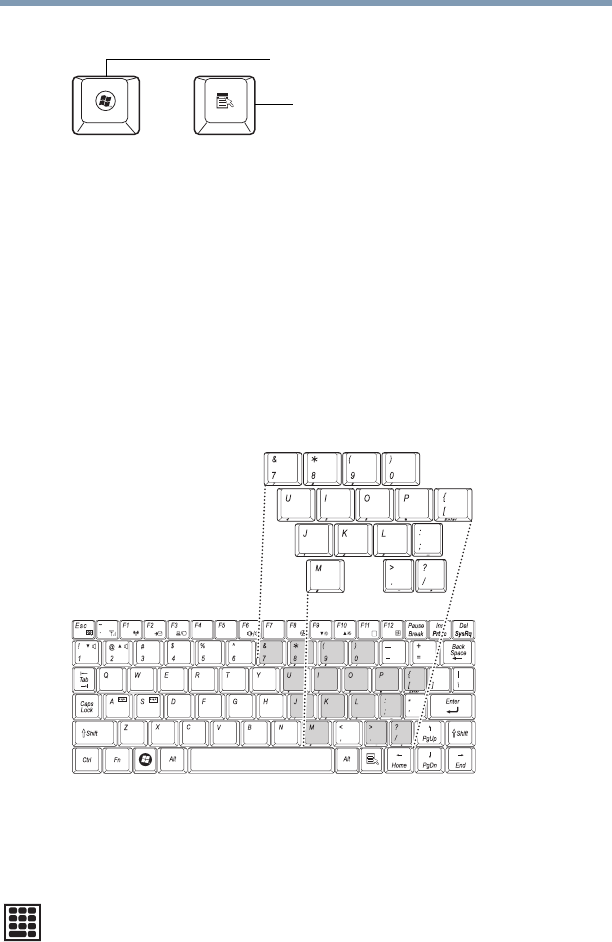
43
Getting Started
Using the keyboard
Special Windows® keys
(Sample Illustration) Special Windows® keys
Your computer’s keyboard has one key and one button that have
special functions in Windows®:
❖Windows® button—Opens the Start menu
❖Application key—Has a similar function as the secondary
mouse button
Overlay keys
The keys with blue numbers and symbols on the front of them form
the numeric overlay. This overlay lets you enter numeric data as
you would using the 10-key keypad on a desktop computer’s
keyboard.
(Sample Illustration) Numeric overlay
Using the overlay to type numeric data
The keys with the numbers on their left front edge are the numeric
overlay keys.
To turn the numeric overlay on, press Fn and F11 simultaneously.
The numeric mode light on the system indicator lights glows when
the numeric overlay is on.
To disable the numeric overlay, hold down the Fn key and press F11
again. The numeric mode light on the system indicator lights goes
out.
Application key
Windows® button
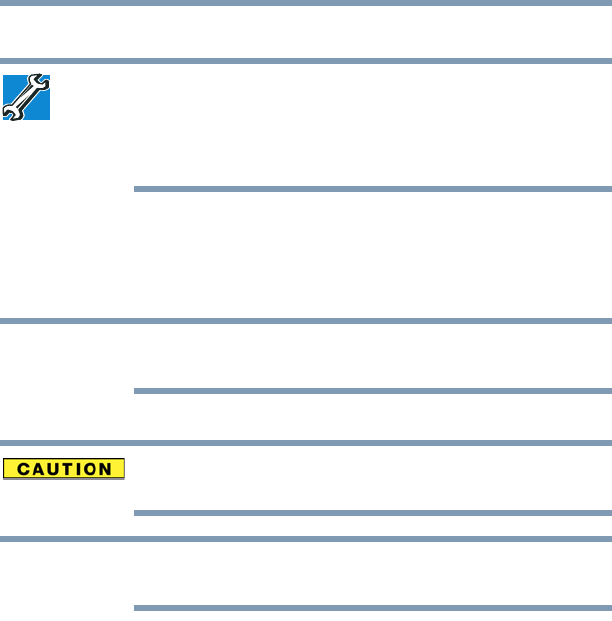
44 Getting Started
Setting up your computer
Setting up your computer
TECHNICAL NOTE: You must complete all setup steps up to and
including “Setting up your software” on page 44 before adding
external or internal components to your computer. These
components include, but are not limited to, a mouse, keyboard, or
printer.
Your computer contains a rechargeable main battery that needs to
be charged before you can use it.
To use external power or to charge the battery you must attach the
AC adaptor. See “Connecting to a power source” on page 29.
Please handle your computer carefully to avoid scratching or
damaging the surface.
Setting up your software
When you turn on the computer for the first time, do not turn off the
power again until the operating system has loaded completely.
The names of windows displayed, and the order in which windows
appear, may vary according to your software setup choices.
The first time you turn on your computer, the Setup Wizard guides
you through steps to set up your software.
1From the Welcome screen click Next to enter the Setup
Wizard.
2Confirm acceptance of Microsoft’s End User License
Agreement and click Next.
3Select the appropriate option from the Help Protect Your
Computer screen and click Next.
4Enter the computer name and description and click Next or Skip.
5Select how your computer will connect to the Internet and click Next.
The computer will pause for a moment while checking for an
Internet connection.
If an Internet connection could not be found, a window will
display the message: “An Internet connection could not be
chosen.” Click Next to continue.
NOTE
NOTE

45
Getting Started
Registering your computer with Toshiba
If you are connecting your computer to a network, consult your
system administrator before you choose your computer name and
network settings.
6Follow the remaining screen prompts to complete the setup process.
Once you click the final screen, your computer restarts
automatically.
Registering your computer with Toshiba
Product registration is strongly recommended, and allows Toshiba
to send you periodic updates, announcements, and special offers
applicable to your product. Product registration can be completed
by either visiting the Toshiba Web site at
http://www.register.toshiba.com, or by double-clicking the Toshiba
Resources icon on your desktop and then double-clicking Toshiba
Registration. Failure to complete Product Registration will not
diminish Customer rights under the Toshiba standard limited
Warranty.
To register online, you must be connected to the Internet.
Adding optional external devices
Before adding external devices or memory, Toshiba recommends
setting up your software. See “Setting up your software” on page 44.
After starting your computer for the first time you may want to:
❖Connect a mouse
❖Connect a full-size keyboard
❖Connect an external monitor
❖Connect a local printer
❖Connect an optional external disk drive
❖Connect an optional external optical drive
Refer to the documentation included with each device for additional
information.
NOTE
NOTE
NOTE
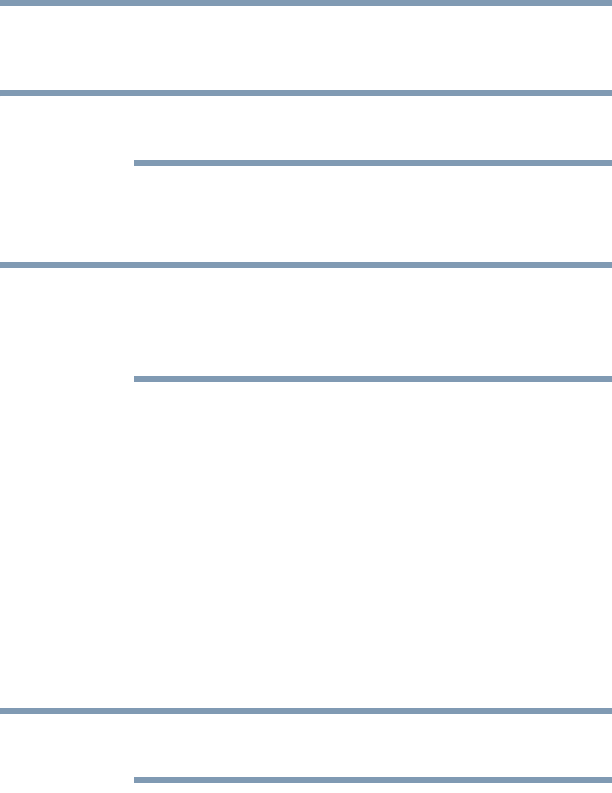
46 Getting Started
Internal storage drive recovery using external ODD/storage
Internal storage drive recovery using external ODD/storage
drive
To purchase an optional external optical drive, visit the Toshiba Web
site at accessories.toshiba.com.
Your computer has been configured with a hard disk partition to
allow you to recover your hard disk drive or reinstall selected
applications and software features or utilities.
It is strongly recommended that you create recovery DVDs before
using your system. For more information on creating Recovery
media see “Creating Recovery DVD Media using an external ODD
drive” on page 46.
Using the HDD Recovery, you can:
❖Create Hard Drive Recovery DVDs using an optional external
writable optical drive.
❖Recover your hard disk drive to the factory-set default.
❖Recover just your C: drive, leaving any other partitions you
may have created intact, for example, a D: drive.
❖Recover your hard disk drive to the factory-set default without
the HDD Recovery partition.
❖Reinstall drivers and applications which were bundled with
your computer.
Creating Recovery DVD Media using an external ODD drive
To purchase an optional external optical drive, visit the Toshiba Web
site at accessories.toshiba.com.
Depending on your system configuration, you may be able to copy
the hard drive recovery to DVD which gives you the ability to
recover your hard disk drive and recover your system if the hard
drive recovery partition has been deleted or the hard disk has been
replaced on your computer.
NOTE
NOTE
NOTE

47
Getting Started
Internal storage drive recovery using external ODD/storage
The system will prompt you to insert the appropriate number of blank
DVDs to copy the hard drive recovery. If your external optical disc drive
is not writable, contact Toshiba Customer Support to obtain the
Recovery media for your system.
The Toshiba Customer Support Center in the United States is
(800) 457-7777, outside the United States it is (949) 859-4273.
To create recovery DVDs:
1Click Start, All Programs, Toshiba, Recovery, and then
Recovery Disc Creator.
2Select DVD (to create Recovery media on DVDs).
3Select the items you want to copy by clicking the check box
next to the item’s Name—recovery files, applications (original
bundled drivers and applications), or both the recovery files
and applications.
4Click Create.
5Insert the first blank DVD into your optional external writable
optical drive when prompted.
6Follow the on-screen prompts for completing the copy process.
For more information on using the Recovery media you have
created with the preceding steps see “Internal Storage Drive using
the Recovery media” on page 47.
Internal Storage Drive using the Recovery media
To purchase an optional external optical drive, visit the Toshiba Web
site at accessories.toshiba.com.
If you need to recover your computer to its default factory state, you
can rebuild the system using your Hard Drive Recovery Utilities.
To recover your hard disk drive using the utilities burned to DVDs
(refer to “Creating Recovery DVD Media using an external ODD
drive” on page 46):
1Insert the first recovery DVD into your optical drive and power
on the computer.
2When the initial screen displays, press F12.
The boot menu appears.
NOTE
NOTE
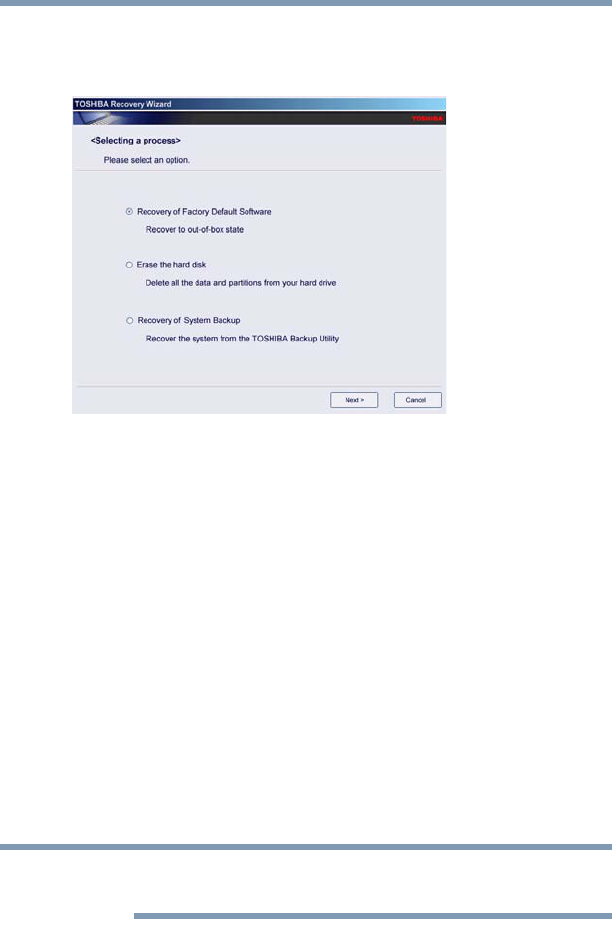
48 Getting Started
Caring for your computer
3Using the arrow keys, select the DVD option and press Enter.
The system will boot up to the Toshiba Recovery Wizard
screen.
(Sample Image) Toshiba HDD Recovery Utility screen
Checking the HDD operating status
After restoring your hard disk drive, you can check its status as
follows:
1Click Start.
2Right-click My Computer.
3Select Manage.
4Click Disk Management.
5Highlight the hard disk drive in the Volume list to display its
status in the lower portion of the screen.
Caring for your computer
This section gives tips on cleaning and moving your computer. For
information about taking care of your computer’s battery, see
“Taking care of your battery” on page 36.
Please handle your computer carefully to avoid scratching or
damaging the surface.
NOTE
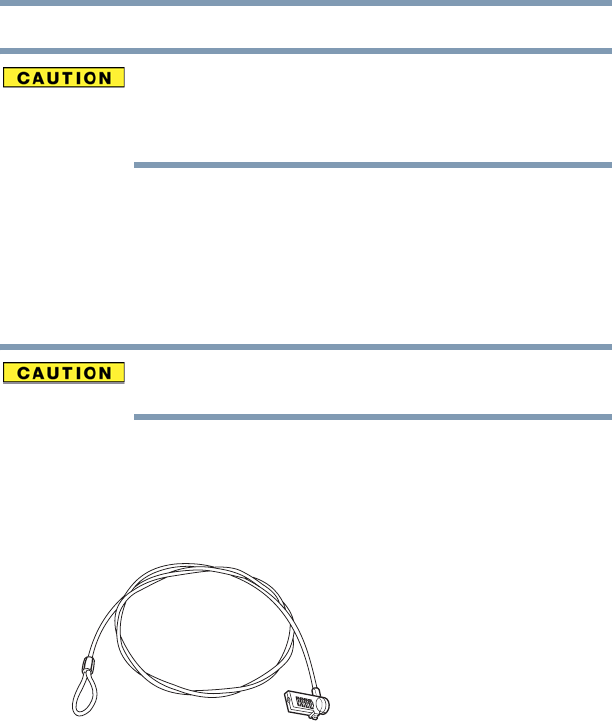
49
Getting Started
Caring for your computer
Cleaning the computer
Keep liquids, including cleaning fluid, out of the computer’s
keyboard, speaker, and other openings. Never spray cleaner directly
onto the computer and/or display. Never use harsh or caustic
chemical products to clean the computer.
To keep your computer clean, gently wipe the display panel and
exterior case with a lightly dampened cloth.
Moving the computer
Before moving your computer, even across the room, make sure all
drive activity has ended (the drive indicator light stops glowing) and
all external peripheral cables are disconnected.
Do not pick up the computer by its display panel or by the back.
Doing so could damage the system.
Using a computer lock
You may want to secure your computer to a heavy object such as
your desk. The easiest way to do this is to purchase an optional
computer lock cable. For more information on purchasing a cable
lock, visit accessories.toshiba.com.
(Sample Illustration) Computer lock cable
To secure the computer:
1Wrap the cable through or around some part of a heavy object.
Make sure there is no way for a potential thief to slip the cable
off the object.
2Pass the locking end through the loop.
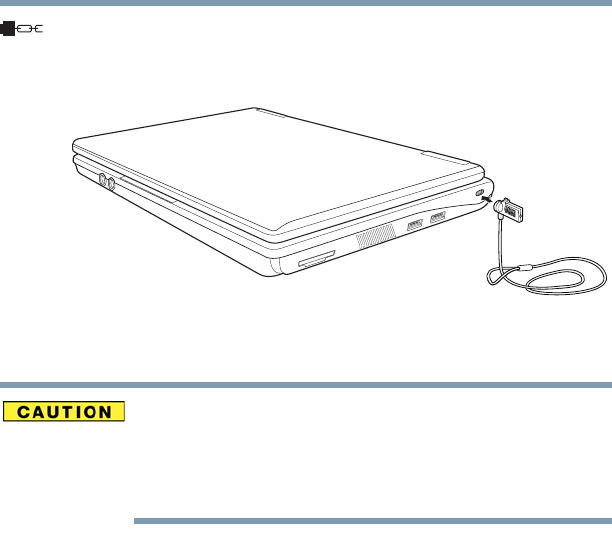
50 Getting Started
Turning off the computer
3Insert the cable’s locking end into the security lock slot on your
computer, then engage the locking device.
The computer is now securely locked.
(Sample Illustration) Attaching security lock cable
Turning off the computer
Pressing the power button before shutting down the Windows®
operating system could cause you to lose your work. Make sure the
system indicator panel’s storage drive light and the drive-in-use light
are off. If you turn off the power while a disk/disc is being accessed,
you may lose data or damage the disk/disc and/or drive.
It is a good idea to turn off your computer when you are not using it
for a while.
If you are using the computer for the first time, leave the computer
plugged into a power source (even though the computer is off) to
fully charge the main battery.
Options for turning off the computer
Depending on the operating system installed, you have more than
one option available for turning off the computer: Turn Off or Shut
Down, Hibernate, and Standby. Each option has its advantages.
Turn Off or Shut Down
Factors to consider when choosing either Turn Off or Shut Down:
❖Use the Turn Off command if you are not connected to a
domain server.
❖Use the Shut Down command if you are connected to a domain
server.
❖If you have work in progress and are not connected to a
network, use the Windows® Standby or Hibernate commands
to save your system settings so that, when you turn on the
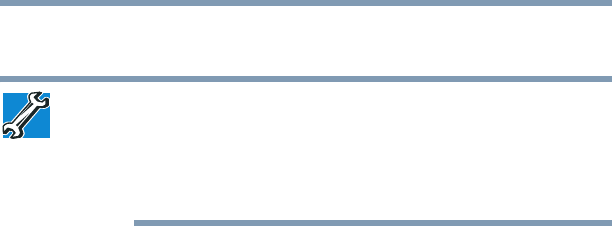
51
Getting Started
Turning off the computer
computer again, you will automatically return to where you left
off.
TECHNICAL NOTE: Before using any of these options to shut down
or turn off your computer, save your files and make sure all disk/disc
activity lights are off.
If you change your mind and decide to continue working after all,
wait a few seconds before turning the computer on again.
Hibernation mode
Hibernation mode shuts the computer down completely, but it first
saves the current state of the computer to the internal storage drive.
Since Hibernation mode does not require power to maintain the
saved information, system settings are retained indefinitely.
Factors to consider when choosing Hibernation:
❖While in Hibernation mode, the computer uses no main battery
power.
❖Because the state of the system is stored on the internal storage
drive, no data is lost if the main battery discharges.
❖Restarting from Hibernation takes less time and consumes less
main battery power than restarting from turning off the
computer.
❖Since information is being retrieved from the hard disk rather
than from memory, restarting from Hibernation takes a little
more time and consumes more main battery power to start up
than when restarting from Standby.
❖When starting up again, the computer returns to the state in
which you left it, including all open programs and files you
were using.
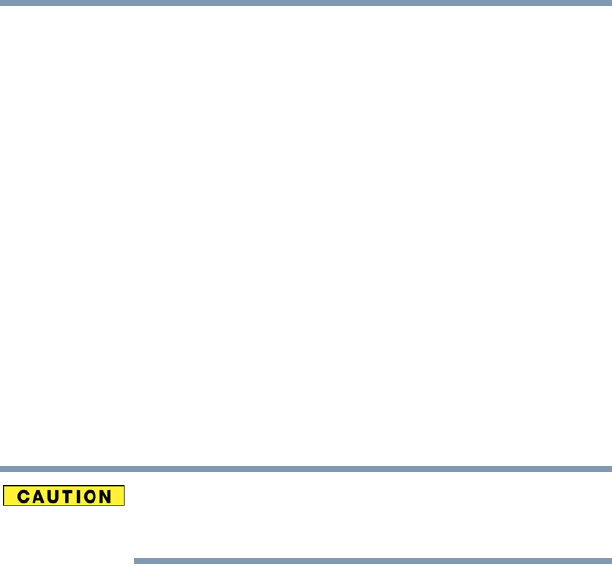
52 Getting Started
Turning off the computer
Standby mode
The Standby command places the computer into a power-saving
mode. Standby holds the current state of the computer in system
memory (RAM) so that, when you restart the computer, you can
continue working from where you left off.
Factors to consider when choosing Standby:
❖While in Standby mode, the computer uses some main battery
power.
❖The Standby command does not store unsaved information on
your hard disk. You should save your work before putting your
computer on Standby.
❖Restarting from Standby takes less time and consumes less
main battery power than restarting from turning off the
computer or using Hibernation mode.
❖When starting up again, the computer returns to the mode in
which you left it, including all open programs and files you
were using.
If you power down using the Standby command and the main battery
discharges fully, your unsaved information will be lost. Be sure to
save your work first.
Closing the display panel
After you have turned off the computer, close the display panel to
keep dust and dirt out of the computer.
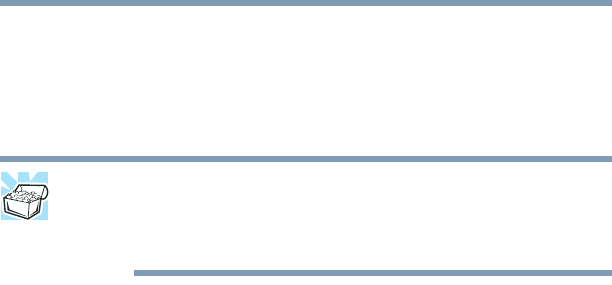
53
Chapter 2
Features of Your Computer
Exploring the desktop
The desktop is the launching pad for everything you can do in the
Windows® operating system. You use its features to start programs,
find documents, set up system components, and perform most other
computing tasks.
HINT: The illustrated examples in this guide may appear slightly
different from the screens displayed by your system. The differences
are not significant and do not indicate any change in the functionality
of your system.
Starting a program
The easiest way to start a program is to double-click the name of
the file that contains the information you want to work on. To find
the file, use My Computer or Windows® Explorer.
If you prefer to open the program first, you have two options. You
can:
❖Double-click the icon for the program on your desktop
❖Use the Start menu

54 Features of Your Computer
Starting a program
When you install a program, the operating system usually puts an
icon in the All Programs menu.
1To start a program that has an icon in the All Programs menu,
click Start, and then All Programs.
The Windows® operating system displays the All Programs
menu, which lists programs and program groups.
2Locate the program you want to work on and then click the
folder to start the program.
Use Windows® Explorer or My Computer to locate the
program file
To use this method, you should know the file name and location of
the program’s executable file (this file ends with .exe).
1Click Start, All Programs, Accessories, Windows Explorer,
and in the left part of the window, click My Computer.
2In the left part of the window, click the line that ends in “(C:).”
3In the left part of the window, under the C: icon, double-click
the folder containing the program, in this case Program Files.
Windows® Explorer shows the contents of the Program Files
folder on the right side of the window. The left side of the
window shows all the folders contained within the Program
Files folder.
4Locate the program you want to work on and then click the
folder to start the program.
Use the Run dialog box
1To locate a program, click Start, and then Run. The Run
dialog box appears.
2In the Run dialog box, type the command line. For a program
in the Windows® folder, type just the program name.
Otherwise, type the full file path. For example, to access
WordPad, type:
c:\Program Files\Windows NT\Accessories\wordpad.exe, then click
OK.
3If you do not know the location, you can search for it by
clicking Start, then Search, and then following the on-screen
instructions.

55
Features of Your Computer
Setting up for communications
Setting up for communications
To connect to the Internet, or use an online service, you need:
❖A browser or communications program
❖An Internet Service Provider (ISP) or online service if you plan
to use the Internet
❖A way to connect to the ISP (for example Wi-Fi®/LAN etc.)
Using Wireless LAN connectivity
Wireless connectivity and some features may require you to
purchase additional software, external hardware or services.
Availability of public wireless LAN access points may be limited.
Your system comes with a wireless LAN module. This is a
technology that expands wireless communication beyond
networking equipment, and can connect many different kinds of
electronic devices without the need for cables.
For information on how to set up a wireless connection, refer to
your wireless networking device documentation or your network
administrator.
To use your wireless communication, make sure the wireless
indicator light is lit. To enable/disable the wireless devices installed
in your computer, press Fn+F1.
Connecting your computer to a network
You can connect your computer to a network to increase its
capabilities and functionality using one of its communication ports.
Accessing a network
To access a network at the office, connect an Ethernet cable to the
Network port (RJ45) on your computer. For specific information
about connecting to the network, consult your network
administrator. Many hotels, airports, and offices offer Wi-Fi®
access. If your computer has Wi-Fi®, ask them for help when
connecting to their Wi-Fi® network.
NOTE
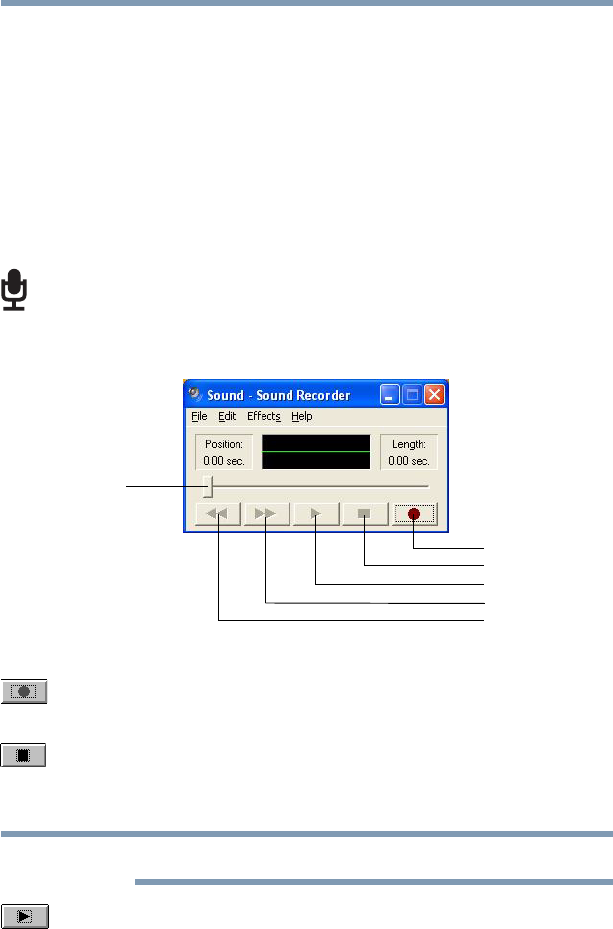
56 Features of Your Computer
Exploring audio features
Exploring audio features
You can use your computer to record sounds using the computer’s
internal microphone or an optional external microphone. You can
listen to sound files using the built-in speakers, headphones, or
external speakers.
Recording sounds
You may record sounds using the computer’s internal microphone or
by connecting an optional external microphone.
Using a microphone
1If you want to use an external microphone, connect it to the
computer.
2Click Start, All Programs, Accessories, Entertainment, and
then Sound Recorder.
(Sample Image) Sound Recorder screen
3Click the Record button.
4Speak normally into the microphone.
5When you have finished recording, click the Stop button.
The Sound Recorder window displays the new sound file as a
waveform.
You can only record 60 seconds at a time.
6To hear what you just recorded, click the Play button.
7To save the file, click File, and then Save.
Record
Stop
Play
Skip forward
Skip backward
Positioning
bar
NOTE
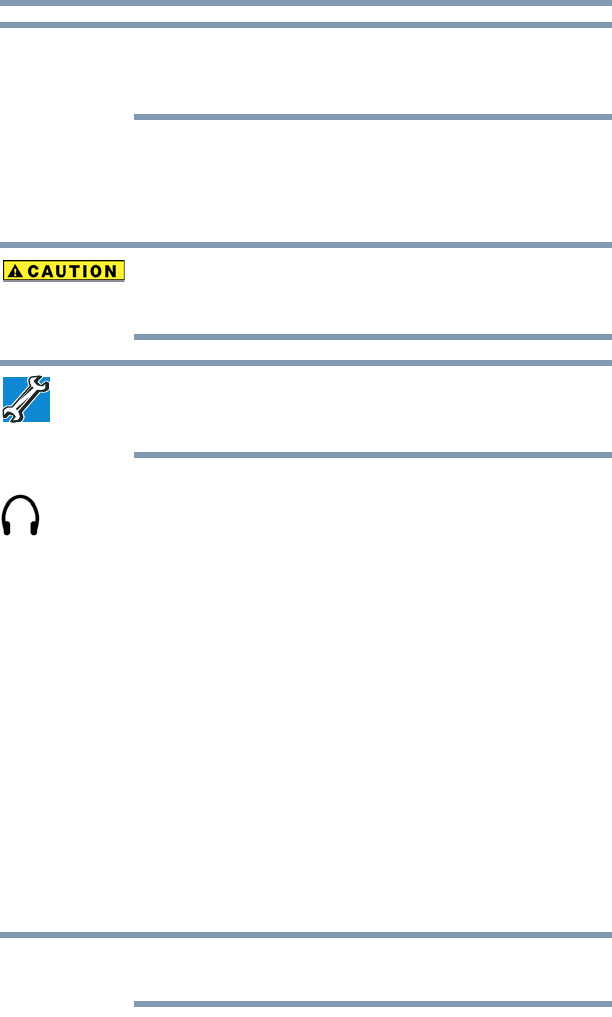
57
Features of Your Computer
Web Camera
The microphone on your computer might be set to Mute. To check
this, click Start, All Programs, Accessories, Entertainment, and then
Volume Control.
Using external speakers or headphones
Your computer is equipped with a full stereo sound system with
internal speakers. Instead of using the internal speakers, you can
connect headphones or a pair of external stereo speakers.
Before putting on headphones to listen, turn the volume down. Do
not set the volume too high when using headphones. Continuous
exposure to loud sound can harm your hearing.
TECHNICAL NOTE: When using amplified speakers, use speakers
that require an external power source. Other types of speakers will be
inadequate to produce sound from the computer.
To play back sound files through external speakers or headphones:
1Locate the headphone jack on the computer.
2Using any necessary adapters, plug the cable from the
headphones or external speakers into the headphone jack.
The headphone jack requires a 16-ohm stereo mini-jack.
To adjust the volume:
❖For external speakers, use the volume controls on each speaker.
❖For headphones, use the computer’s volume control.
Web Camera
Your computer may come with a built-in Web Camera. With this
Web Camera you can do the following:
❖Take pictures and record videos with your computer
❖Chat with others and have them see you while using instant
messaging (IM) programs
❖Have video conference calls
To E-mail, instant message or video conference, you must be
connected to the Internet.
NOTE
NOTE
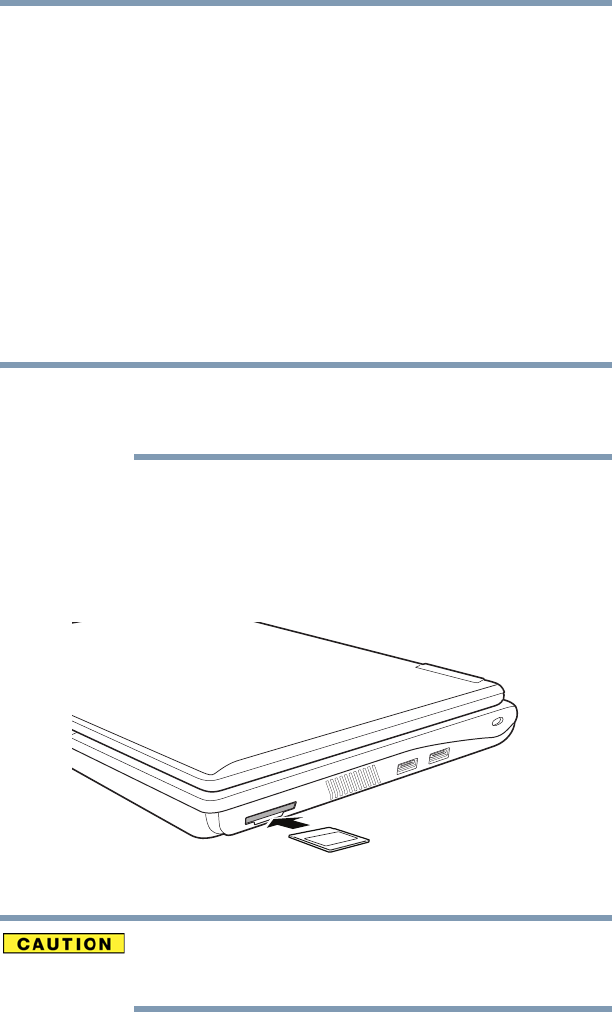
58 Features of Your Computer
Using the Bridge Media Adapter Slot
Depending on your computer model, the process of sending E-mail,
taking pictures or recording video messages may vary.
The Web Camera software, by default, may already be running in
the System tray.
Using the Bridge Media Adapter Slot
The Bridge Media Adapter slot supports the use of Memory Stick®,
Memory Stick DUO™, Secure Digital™ (SD™), or
MMC™ (MultiMediaCard™). These media can be used with a
variety of digital products: digital music players, cellular phones,
PDAs, digital cameras, digital video camcorders, etc.
The Bridge Media Adapter slot may also support other types of
media. For a complete list of supported media, visit Toshiba’s Web
site at accessories.toshiba.com.
Do not use the Copy Disk function for this type of media. To copy
data from one media to another, use the drag-and-drop feature of the
Windows® operating system.
Inserting memory media
The following instructions apply to all types of supported media
devices.
1Turn the media so that the contacts (metal areas) are face down.
2Push the media into the adapter until it locks in place.
(Sample Illustration) Inserting memory media
When inserting memory media, do not touch the metal contacts. You
could expose the storage area to static electricity, which can destroy
data.
NOTE
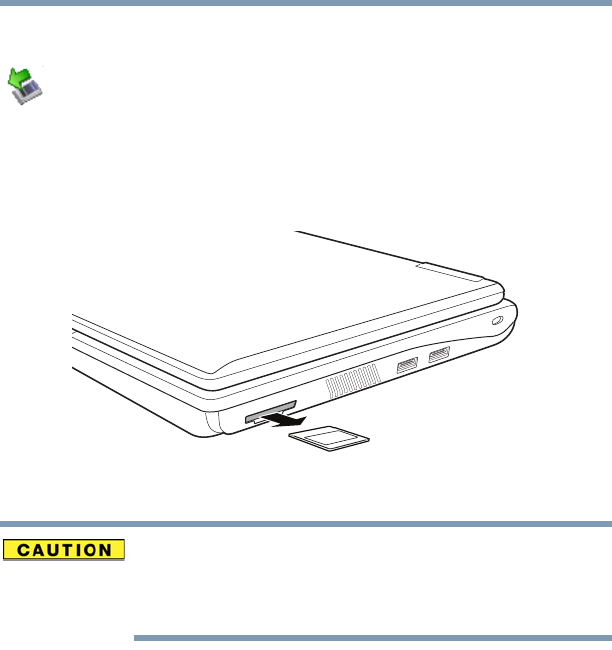
59
Features of Your Computer
Using the Bridge Media Adapter Slot
Removing memory media
1Prepare the media for removal by clicking the Safely Remove
Hardware icon in the System tray and then selecting the card
or device you want to remove.
If the system is unable to prepare the media for safe removal, a
message will tell you to try again later. If the media can be
removed now, the system displays Safe to Remove Hardware.
2Grasp the card and pull it straight out.
(Sample Illustration) Removing memory media
Do not remove memory media while data is being written or read.
Even when the Windows® message “copying...” disappears, writing
to the media might still be in progress and your data could be
destroyed. Wait for the indicator light to go out.
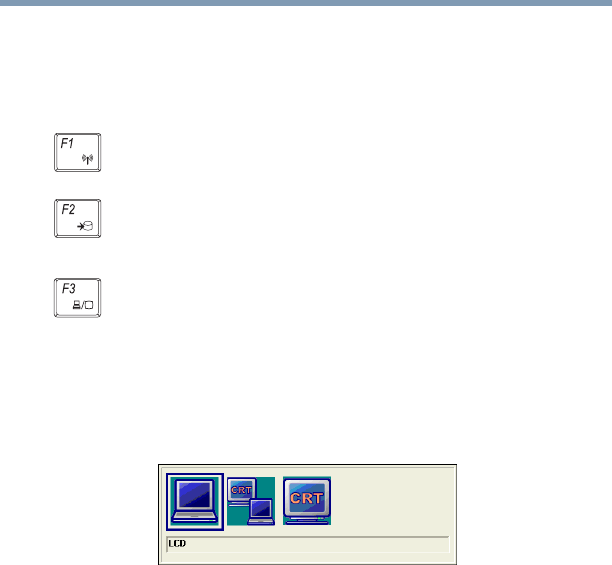
60
Chapter 3
Hot Keys and Utilities
Keyboard hot keys
Hot keys are keys that, when pressed in combination with the Fn
key, turn system functions on and off. Hot keys have a legend on the
key indicating the option or feature the key controls.
Fn + This hot key enables/disables the optional wireless devices
installed in your computer.
Fn + This hot key places the computer into Hibernation mode.
Fn + This hot key cycles through the display options. The display
modes are:
❖LCD—Internal display only
❖LCD + CRT—Internal display and external
monitor simultaneously
❖CRT—External monitor only
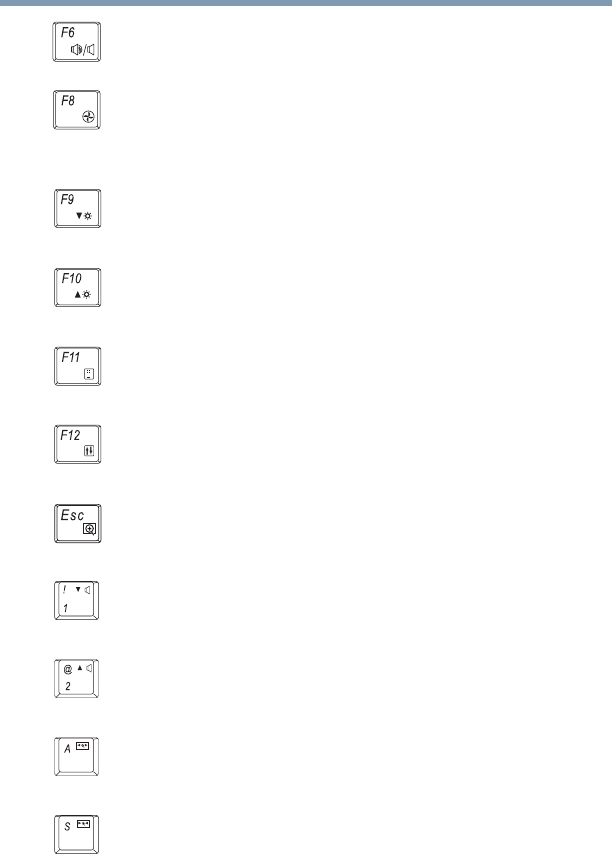
61
Hot Keys and Utilities
Keyboard hot keys
Fn + This hot key enables/disables volume mute on your
computer.
Fn + Silent mode on/off (CPU clock toggle).
Press the Windows® key and Pause key to view CPU clock
speed.
Fn + This hot key decreases the screen brightness.
Fn + This hot key increases the screen brightness.
Fn + This hot key turns the numeric overlay on and off.
Fn + This hot key turns the scroll lock feature on and off.
Fn + This hot key cycles through the screen resolutions.
Fn + This hot key turns the volume down.
Fn + This hot key turns the volume up.
Fn + This hot key allows you to zoom in.
Fn + This hot key allows you to zoom out.
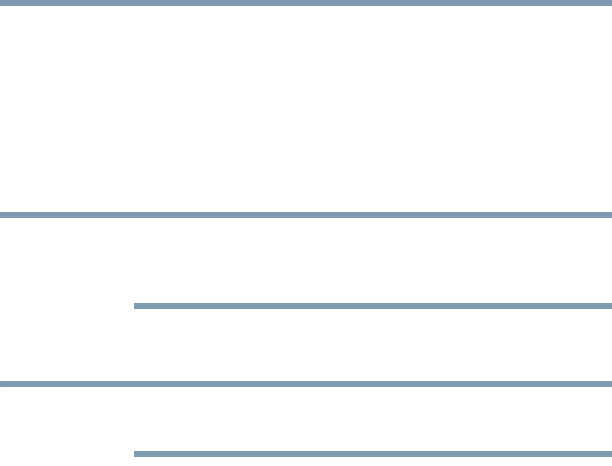
62 Hot Keys and Utilities
Utilities
Utilities
Your computer includes utilities designed to help you to reconfigure
your system to best meet your individual needs. Together, these
allow you to ascertain certain system details, set additional options,
or change default options.
Refer to the online Help documentation within each application for
additional information.
The utilities described in this chapter, and the icons shown in the
sample images are applicable only if the related utility is available on
your system.
ConfigFree®
All references to Bluetooth® in this appendix are applicable only if
Bluetooth® is available on your system.
ConfigFree® is a set of utilities that makes it easy to control
communication devices and network connections. ConfigFree also
lets you identify communication problems and create profiles for
easy switching between locations and communication networks.
The ConfigFree utilities include the following:
❖Connectivity Doctor—The Connectivity Doctor utility is used
to analyze network connections and fix networking problems
with your computer. For more information, see “Connectivity
Doctor” on page 64.
❖Search for Wireless Devices—The Search for Wireless
Devices utility searches for wireless LAN and Bluetooth®
devices used in the neighborhood, and displays information
about them on a virtual map.
❖Profile Settings—The Profiles utility lets you switch between
network configurations. For more information, see “Profile
Settings” on page 65.
❖ConfigFree SUMMIT—The ConfigFree SUMMIT utility is
used to connect with other ConfigFree users for file sharing.
ConfigFree also includes a screen saver that you can customize by
adding identifying text to devices. Click Options on the
Connectivity Doctor screen to access the screen saver option.
NOTE
NOTE
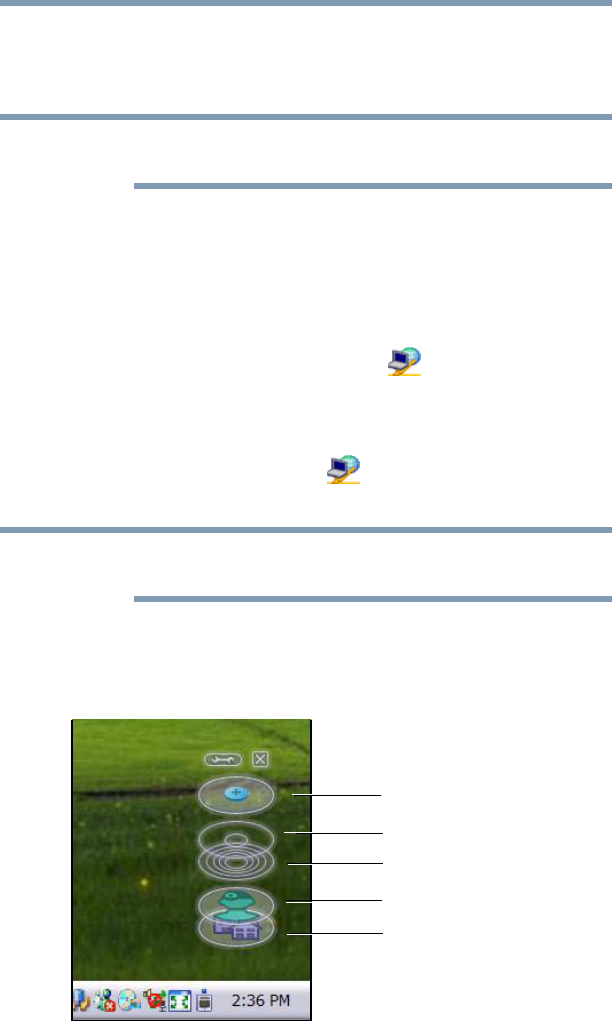
63
Hot Keys and Utilities
Getting Started
Getting Started
This section contains information about the ConfigFree® main
screen, and how to start and set up ConfigFree.
For more detailed information on setting up and using ConfigFree,
see the Help File included in the application.
Starting ConfigFree®
To start ConfigFree®, be sure the computer has a wired or wireless
connection. Then perform any of the following steps:
❖Click Start, All Programs, Toshiba, Networking, and then
ConfigFree.
❖Double-click the ConfigFree icon on the Taskbar.
❖Press the TOSHIBA Assist button (if applicable to your
system) to open the TOSHIBA Assist, and then click the
ConfigFree icon.
❖Click the ConfigFree icon on the Taskbar, and then click
the desired utility.
If your computer is not connected to a network, the ConfigFree icon
on the Taskbar is displayed with an “X.”
When you start a search for wireless devices, ConfigFree Launcher
displays on your computer desktop. You can then click the
appropriate icon on the Launcher to start the desired ConfigFree
utilities.
(Sample Image) ConfigFree Launcher
NOTE
NOTE
Bluetooth®
Wireless LAN
Connectivity Doctor
Profiles
SUMMIT
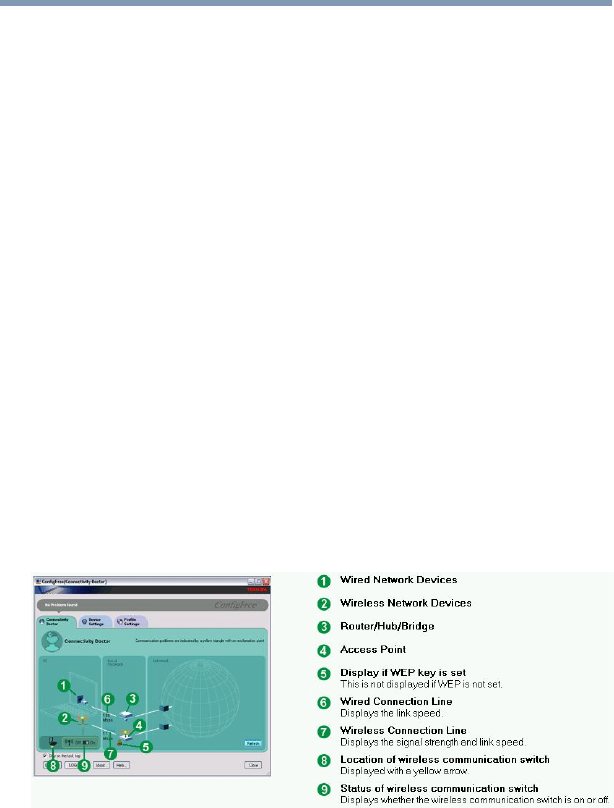
64 Hot Keys and Utilities
ConfigFree® Utilities
ConfigFree® Utilities
Connectivity Doctor
The Connectivity Doctor lets you analyze your network
connections and fix network connection problems. Using
Connectivity Doctor, you can view detailed network information by
simply moving the mouse pointer.
The Connectivity Doctor works with the following network
devices:
❖Wired and wireless network devices
❖Routers, hubs, and bridges
❖Access points
The Connectivity Doctor displays the following information:
❖WEP (Used, not Used)
❖Wired connection line (link speed)
❖Wireless connection line (signal strength and link speed)
❖Location of wireless communication switch (identified with a
yellow arrow)
❖Status of wireless communication switch (on or off)
(Sample Image) Connectivity Doctor screen
Moving the mouse pointer over a wired or wireless network device
icon displays information about the device, such as its IP address,
subnet mask, and MAC address. A wireless network device also
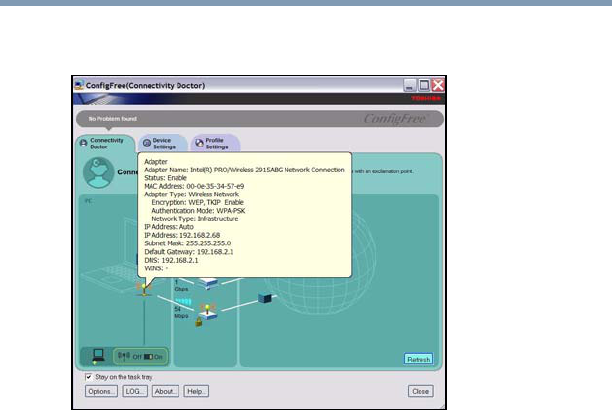
65
Hot Keys and Utilities
ConfigFree® Utilities
shows information such as the network SSID and the device’s
Wired Equivalent Privacy (WEP) key settings.
(Sample Image) Viewing device information
Profile Settings
The Profile Settings utility lets you save network settings in
“profiles.” ConfigFree® profiles are useful for easily switching
network settings and devices.You can switch network settings
simply by selecting the profile with the desired settings.
If you visit a client company occasionally, for example, you can set
up a profile to match that environment and connect to the network.
Similarly, users who access networks in the office and at home can
set up profiles to handle these networking environments.
A profile contains the currently configured network settings on the
computer, as well as information about any network devices. The
following settings can be saved (or “captured”) in a profile:
❖Internet settings—includes LAN settings (proxy server
settings) and the address of a home page that opens
automatically when Internet Explorer® starts
❖Devices—lets you enable or disable settings of wired and
wireless network devices, infrared devices, and set the power
status of Bluetooth® antennas
❖TCP/IP settings—includes DHCP, IP address, subnet mask,
default gateway, DNS server, and WINS server settings
❖Personal firewall settings for Internet connections
❖Dial-up connection settings for the default connection
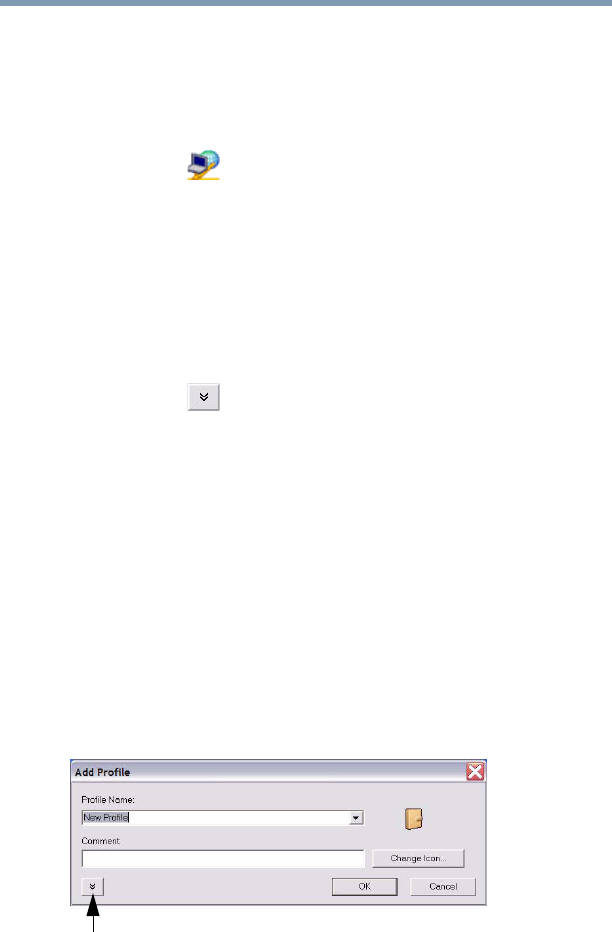
66 Hot Keys and Utilities
ConfigFree® Utilities
❖File and printer sharing settings
❖Printer settings for the default printer
❖Bluetooth® Security Level (for example, high or medium)
To create a profile:
1Click the icon in the system tray.
2Move the pointer to Profile.
3Click Add. The Add Profile screen appears.
4Select Capture and click OK. The Add Profile screen appears.
5Enter the name of the profile you want to create.
6Enter any optional comments, if desired.
7Click Change Icon and select an icon for this profile.
8Click the icon at the bottom of the screen to display more
capture options.
9Under Captured Items, select the items you want to capture
for this profile.
10 If connecting with a wireless network, select the desired Auto
Switch Settings. (These options are unavailable if wireless
devices have been disabled.)
11 Under Execute this program after switching, click the
Browse button and select the program, file, or Web site URL
that is to start after switching to this profile.
For example, to have Internet Explorer® start in the Windows®
operating system after switching profiles, type:
C:\Program Files\Internet Explorer\IEXPLORE.EXE
12 Click OK.
(Sample Image) Add Profile screen
Press to show more capture options

67
Hot Keys and Utilities
ConfigFree® Utilities
The online Help provides real-world examples of setting up profiles
for different networking environments.
After you set up one or more profiles, you can check their settings
and fine-tune them as necessary. Profiles can also be imported and
exported. This feature is useful when transferring profile settings to
other computers. For more information about modifying,
importing, and exporting profiles, refer to the online Help.
NOTE

68
Chapter 4
If Something Goes Wrong
Some problems you may encounter when using your computer are
relatively easy to identify and solve. Others may require help from
your network administrator or the manufacturer of the software
program.
This chapter aims to help you solve many problems by yourself. It
covers the problems you are most likely to encounter.
If all else fails, contact Toshiba. For more information on support
and contacting Toshiba, see “Toshiba’s online resources” on
page 24.
Problems when you turn on the computer
These problems may occur when you turn on the power.
The computer will not start.
Make sure you attached the AC adaptor and power cord/cable
properly or installed a charged battery.
Press and hold the power button for at least 10 seconds.
If you are using the AC adaptor, check that the wall outlet is
working by plugging in another device, such as a lamp.
Verify that the computer is on by looking at the on/off indicator. If
the indicator is glowing, the computer is on.

69
If Something Goes Wrong
Problems when you turn on the computer
If you are using an AC adaptor, verify that the computer is receiving
power from the external power source by looking at the AC power
light. If the indicator is glowing, the computer is connected to a live
external power source.
The computer starts but when you press a key nothing
happens.
Verify that the active program accepts text input. Try clicking your
mouse on an area where you can type text and try typing again.
Your computer may be in Standby mode and have a software or
resource conflict. When this happens turning the power on returns
you to the problem instead of restarting the system. To clear the
condition, press Ctrl, Alt, and Del simultaneously.
Clearing the condition may get the computer running, but it will not
solve a resource conflict. Read the documentation that came with
the conflicting device or see Help and Support in your operating
system.
The computer is not accessing the internal storage drive or
the optional external diskette drive.
Your computer normally loads the operating system from the
internal storage drive. If you have an internal storage drive problem,
you will not be able to start the computer. Insert a system diskette
into the optional external diskette drive and press F12 when the
machine starts and use the arrow keys to select the boot-up device.
The computer displays the WARNING RESUME FAILURE message.
The computer was placed in Standby mode and the battery has
discharged. Data stored in the computer’s memory has been lost.
Data stored in the computer’s internal storage drive may not be
affected.
Always save your data even when you are using Standby. If your
battery fully discharges, information that has not been saved will be
lost. Your computer can be configured to warn you when the battery
is running low see “What to do when the main battery runs low” on
page 36.
If you are running on battery power, it is recommended that you do
not leave the computer in Standby mode for long periods of time.
To charge the battery, leave the computer plugged into a live wall
outlet for several hours. For more information see “Charging the
main battery” on page 33.

70 If Something Goes Wrong
The Windows® operating system is not working
The computer displays the Non-System disk or disk error message.
Make sure there is no diskette in the optional external diskette
drive. If there is a diskette in the drive, remove it and press any key
to continue. If pressing any key does not work, press Ctrl, Alt, and Del
to restart the computer. For more information see “The computer is
not accessing the internal storage drive or the optional external
diskette drive.” on page 69.
The Windows® operating system is not working
Once you are familiar with the desktop and used to the way the
operating system responds to your work routine, you can easily
detect if the operating system is not working correctly. For
example:
❖The operating system fails to start after the Starting Windows XP
message appears.
❖The operating system takes a long time to start.
❖The operating system responds differently from the normal
routine.
❖The screen does not look right.
Unless a hardware device has failed, problems usually occur when
you change the system in some way such as installing a new
program or adding a device.
If you experience any of these problems, use the options in the
Startup menu to fix the problem.
Using Startup options to fix problems
If the operating system fails to start properly, you may have to
change your system’s configuration or verify the startup procedure
to fix the problem. To do this, use the options in the Startup menu.
To open the Startup menu:
1Restart your computer.
2Press F8 when your computer starts and before Windows® starts
loading.
The Windows® Advanced Options menu displays these
options:
❖Safe Mode
❖Safe Mode (with Networking)
❖Safe Mode (with Command Prompt)

71
If Something Goes Wrong
The Windows® operating system is not working
❖Enable Boot Logging
❖Enable VGA Mode
❖Last known good configuration (your most recent settings
that worked)
❖Directory Services Restore Mode (Windows® domain
controllers only)
❖Debugging Mode
❖Start Windows® normally
❖Reboot
❖Return to OS Choices (menu)
See your Windows® documentation for further explanation.
If your computer is connected to a network, the Startup menu may
display different versions of Safe mode.
Internet problems
My Internet connection is very slow.
Many factors contribute to the speed with which you can surf the
Internet. They include: modem speed, telephone line conditions,
time of day (when everyone else is surfing, your access can be
slow) and popularity of the sites you are trying to access. If
accessing a particular site is very slow, try later.
My browser cannot find the URL address I typed in.
Make sure you separated the domain names of the address with the
forward slash (/). Check the spelling of each name and the syntax of
the address carefully. A single incorrect letter or missed character
will make it impossible for your browser to locate the site.
My browser cannot find a site I bookmarked.
The World Wide Web is constantly changing. A site you
bookmarked yesterday may not be available today or its server may
be down for temporary repair. Try again later.
NOTE
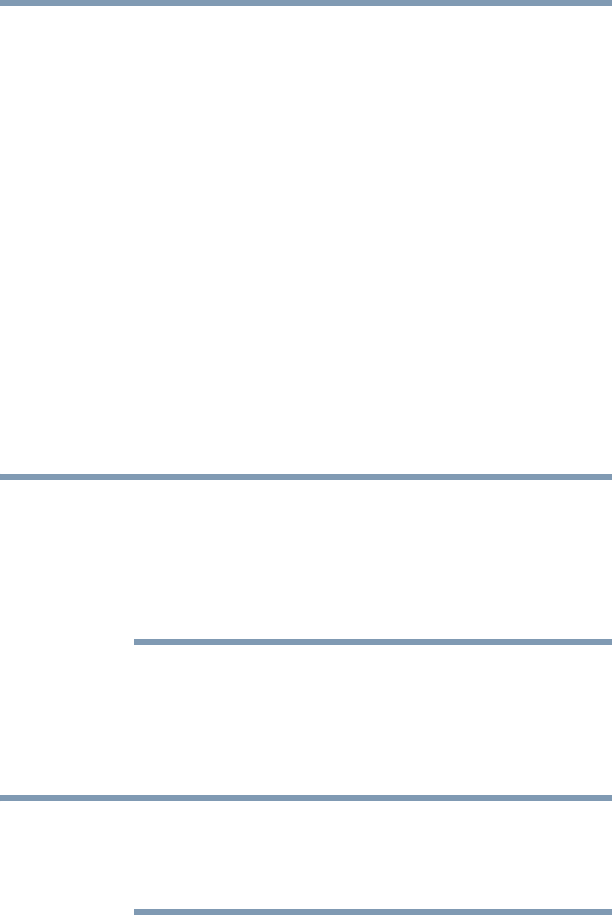
72 If Something Goes Wrong
The Windows® operating system is not working
The Windows® operating system can help you
If the operating system has started properly but you still have a
problem using your computer, the online Help can assist you in
troubleshooting the problem.
To access the Windows® operating system Help and Support:
1Click Start, then click Help and Support.
The Help and Support window appears.
2Then do one or both of the following:
❖In the search field, type in the topic for which you need
help and follow the on-screen instructions.
❖Click a problem you would like help with from the listings
and follow the on-screen instructions.
You can connect to Support Online by clicking Support from the
menu or by going to pcsupport.toshiba.com.
Wireless networking problems
This section provides general troubleshooting tips for networking
problems, specifically wireless (Wi-Fi®) networking.
The terms and concepts used assume a basic understanding of
networks, and may be for more advanced users. If you need
assistance or if you are not familiar with the terminology, please see
Windows® Help and Support or contact your computer technician.
❖Make sure the wireless indicator light is lit. To enable/disable
the wireless devices installed in your computer, press Fn+F1.
❖Verify that your computer can detect access points or routers. If
it can detect a Wi-Fi® access point or router then it may be a
configuration issue.
To determine if your computer has an internal Wi-Fi® adapter, check
the device list in Device Manager (part of the Windows® Control
Panel). Some Toshiba models may have a Wireless antenna ON/OFF
switch even though they do not have an internal Wi-Fi® adapter.
❖Verify that signal strength is good using the utility provided
with the Wi-Fi® adapter.
NOTE
NOTE

73
If Something Goes Wrong
The Windows® operating system is not working
❖If another computer is on the same network, verify that it has
network access, and can connect to the Internet. If, for
example, the other computer cannot browse to a public Web
site, the ISP’s (Internet Service Provider) service may be
disrupted.
❖Verify that the Service Set Identifier (SSID), or network name,
is correct—i.e., that it matches the SSID assigned to the access
point you are attempting to connect through. SSIDs are case-
sensitive. Toshiba provides a Client Manager utility for setting
and managing SSIDs.
❖Check the Control Panel’s Device Manager to verify that the
Wi-Fi® adapter is recognized by the Windows® operating
system, and that the driver is loaded. Carefully note any error
messages—these will be very helpful if you should confer with
a support technician at a later time.
❖Verify that the network connection is configured to obtain its
Internet Protocol (IP) address dynamically:
1Click Start, Control Panel.
2Double-click Network and Internet Connections.
3Right-click the name of your wireless network connection,
then click Properties.
4Select Internet Protocol (TCP/IP), then click Properties.
5Select Obtain an IP address automatically.
6Click OK, then click Close.
❖Use IPCONFIG to verify that the computer has a useful IP
address—one other than the private address of
169.254.xxx.xxx assigned by Windows®.
1Click Start, then click Run...
2Enter Cmd and press Enter.
3Enter IPCONFIG /ALL and press Enter.
The IP address for each active network adapter will be
displayed.
❖Connect your computer directly to your router or broadband
modem, by plugging a standard CAT5 Ethernet patch cable
(sold separately) into your computer's RJ45 Ethernet port. If
your connection problem disappears, the problem lies in the
Wi-Fi® part of your network.

74 If Something Goes Wrong
The Windows® operating system is not working
❖Use the PING command to verify a connection to the gateway
at 192.168.1.1 (a default gateway for most wireless routers).
1Click Start, then click Run...
2Enter Cmd and press Enter.
3Enter PING 192.168.1.1 at the command prompt, and press
Enter.
If “Request Timed Out” or another error message appears in
response, then the problem is probably Wi-Fi®-related.
❖If you have enabled any security provisions (closed system,
MAC address filtering, Wired Equivalent Privacy [WEP], etc.),
check the access point vendor's Web site for recent firmware
upgrades. Problems with WEP keys, in particular, are
frequently addressed in new firmware releases.
The Windows® operating system wireless management
facility does not work.
If you are using an external Wi-Fi® adapter (USB adapter or other
variety), check if the adapter comes with its own management
utility. If it does, the utility may be disabling the Windows®
operating system wireless management facility, in which case you
must use the adapter's management utility. If the documentation
that accompanies the adapter does not provide enough information
to determine if this is the case, contact that vendor's support group
for further advice.

75
Glossary
TECHNICAL NOTE: Some features defined in this glossary may not
be available on your computer.
Acronyms
The following acronyms may appear in this user’s guide.
AC alternating current
BIOS basic input/output system
bps bits per second
CD compact disc
CD-ROM compact disc read-only memory
CD-RW compact disc rewrite memory
CMOS complementary metal-oxide semiconductor
COM1 communications port 1 (serial port)
COM2 communications port 2 (serial port)
CPU central processing unit
DC direct current
DMA direct memory access
DIMM dual inline memory module

76 Glossary
DOS disk operating system
DPI dots per inch
DSTN dual supertwist nematic
DVD digital versatile (or video) disc
DVD-ROM digital versatile (or video) disc read-only memory
ECP enhanced capabilities port
EPROM erasable programmable read-only memory
FAT file allocation table
FCC Federal Communications Commission
GB gigabyte
HDD hard disk drive
HTML Hypertext Markup Language
IEEE Institute of Electrical and Electronics Engineers
I/O input/output
IRQ interrupt request
ISP Internet service provider
KB kilobyte
LAN local area network
LCD liquid crystal display
LPT1 line printer port 1 (parallel port)
LSI large-scale integration
MB megabyte
MIDI Musical Instrument Digital Interface
PC personal computer
PCI Peripheral Component Interconnect
PCMCIA Personal Computer Memory Card International
Association
RAM random access memory
RFI radio frequency interference
ROM read-only memory
RTC real-time clock
SCSI small computer system interface

Glossary 77
SDRAM synchronous dynamic random access memory
SRAM static random access memory
SSD solid state drive
SVGA super video graphics adapter
TFT thin film transistor
USB universal serial bus
URL uniform resource locator
WAN wide area network
www World Wide Web
Terms
The following terms may appear in this user’s guide.
Aactive-matrix display — A liquid crystal display (LCD) made from an
array of liquid crystal cells using active-matrix technology. Also
known as a “TFT display,” in its simplest form there is one thin film
transistor (TFT) for each cell. This type of display works well with
computers because of its shallow depth and high-quality color.
Active-matrix displays are viewable from wider angles than most
passive-matrix displays.
adapter — A device that provides a compatible connection between two
units. For example, the computer’s internal display adapter receives
information from the software and translates it into images on the
screen. An adapter can take a number of forms, from a
microprocessor to a simple connector. An intelligent adapter (one
that is capable of doing some processing) may also be called a
controller.
alternating current (AC) — The type of power usually supplied to
residential and commercial wall outlets. AC reverses its direction at
regular intervals. Compare direct current (DC).
application — A computer program that you use to perform tasks of a
specific type. Applications include word processors, spreadsheets,
and database management systems. See also program.
Bbackup — A copy of a file, usually on a removable disk, kept in case the
original file is lost or damaged.
basic input/output system (BIOS) — See BIOS.

78 Glossary
baud rate — The speed at which a communication device, such as a
printer or modem, transmits information. Baud rate is the number of
signal changes per second (not necessarily the same as bits per
second). See also bits per second.
BIOS (basic input/output system) — Basic instructions, stored in read-
only memory (ROM), containing the information the computer
needs to check hardware and load the operating system when you
start up the computer.
bits per second (bps) — A way of measuring the speed at which
information is passed between two devices. This is the basic unit of
measure used in modem communications, and is similar, but not
identical, to the baud rate. See also baud rate.
boot — To start the computer. The term “boot” originates from bootstrap
program (as in “pulling itself up by its bootstraps”), a program that
loads and initializes the operating system. See also reboot.
boot disk — See system disk.
boot priority (startup sequence) — The order in which the computer
accesses its internal storage drives to locate the startup files. Under
the default startup sequence, the computer looks for the startup files
in the diskette drive before checking the internal storage drive.
bus — An electrical circuit that connects the central processing unit
(CPU) with other parts of the computer, such as the video adapter,
disk drives, and ports. It is the pathway through which data flows
from one device to another. See also bus speed, frontside bus.
bus speed — The speed at which the central processing unit (CPU)
communicates with the other parts of the computer.
Ccache — A section of very fast memory in which frequently used
information is duplicated for quick access. Accessing data from
cache is faster than accessing it from the computer’s main memory.
See also CPU cache, L1 cache, L2 cache.
CD — An individual compact disc. See also CD-ROM.
CD-ROM (compact disc read-only memory) — A form of high-
capacity storage that uses laser optics instead of magnetic means for
reading data. See also CD. Compare DVD-ROM.

Glossary 79
central processing unit (CPU) — The chip that functions as the “brain”
of the computer. It takes information from outside sources, such as
memory or keyboard input, processes the information, and sends the
results to another device that uses the information.
character — Any letter, number, or symbol you can use on the
computer. Some characters are non-printing characters, such as a
paragraph break in a word-processing program. A character
occupies one byte of computer storage.
chip — A small piece of silicon containing computer logic and circuits
for processing, memory, input/output, and/or control functions.
Chips are mounted on printed circuit boards.
click — To press and release the pointing device’s primary button
without moving the pointing device. In the Windows® operating
system, this refers to the pointing device’s left button, unless
otherwise stated. See also double-click.
color palette — A set of specified colors that establishes the colors that
can be displayed on the screen at a particular time.
compatibility — The extent to which computers, programs, or devices
can work together harmoniously, using the same commands,
formats, or language as another.
configuration — (1) The collection of components that make up a single
computer system. (2) How parts of the system are set up (that is,
configured).
controller — A device that controls the transfer of data from a computer
to a peripheral device and vice versa. For example, disk drives,
monitors, keyboards, and printers all require controllers.
CPU — See central processing unit (CPU).
CPU cache — A section of very fast memory residing between the CPU
and the computer’s main memory that temporarily stores data and
instructions the CPU will need to execute commands and programs.
See also cache, L1 cache, L2 cache.
cursor — A symbol that indicates the current position on the screen. The
shape of the cursor varies, depending on the program you are using
and what you are doing.

80 Glossary
Ddefault — The setting selected by a program when the user does not
specify an alternative setting.
device — A component attached to the computer. Devices may be
external (outside the computer’s case) or internal (inside the
computer’s case). Printers, disk drives, and modems are examples of
devices.
device driver — A program (called a “driver”) that permits a computer
to communicate with a device.
dialog box — An on-screen window displayed by the operating system
or a program giving a direction or requesting input from the user.
direct current (DC) — The type of power usually supplied by batteries.
DC flows in one direction. Compare alternating current (AC).
direct memory access (DMA) — A dedicated channel, bypassing the
CPU, that enables direct data transfer between memory and a
device.
directory — See folder.
disable — To turn a computer option off. See also enable.
disc — A round, flat piece of material, designed to be read from and
written to by optical (laser) technology, and used in the production
of optical discs, such as CDs and DVDs. Compare disk.
disk — A round, flat piece of material that can be magnetically
influenced to hold information in digital form, and used in the
production of magnetic disks, such as diskettes and hard disks.
Compare disc. See also diskette, hard disk.
disk drive — The device that reads and writes information and programs
on a diskette or hard disk. It rotates the disk at high speed past one or
more read/write heads.
diskette — A thin, flexible disk in a protective jacket that stores
magnetically encoded data. Diskettes can be removed from the
computer and come in two sizes: 5.25-inch and 3.5-inch. Your
computer uses 3.5-inch diskettes. See also double-density diskette,
high-density diskette.
document — Any file created with an application and, if saved to disk,
given a name by which it can be retrieved. See also file.

Glossary 81
double-click — To press and release the pointing device’s primary
button rapidly twice without moving the pointing device. In the
Windows® operating system, this refers to the pointing device’s left
button, unless otherwise stated.
double-density diskette — A 3.5-inch diskette that can hold up to
720 KB of information (half the capacity of a high-density diskette).
See also diskette, high-density diskette.
download — (1) In communications, to receive a file from another
computer through a modem or network. (2) To send font data from
the computer to a printer. See also upload.
drag — To hold down the mouse button while moving the cursor to drag
a selected object. In the Windows® operating system, this refers to
the left mouse button, unless otherwise stated.
driver — See device driver.
DVD — An individual digital versatile (or video) disc. See also DVD-
ROM.
DVD-ROM (digital versatile [or video] disc read-only memory) — A
very high-capacity storage medium that uses laser optics for reading
data. Each DVD-ROM can hold as much data as several CD-ROMs.
Compare CD-ROM.
Eemulation — A technique in which a device or program imitates another
device or program.
enable — To turn on a computer option. See also disable.
executable file — A computer program that is ready to run. Application
programs and batch files are examples of executable files. Names of
executable files usually end with a .bat or .exe extension.
expansion device — A device that connects to a computer to expand its
capabilities. Other names for an expansion device are port expander,
port replicator, docking station, or network adapter.
extension — See file extension.
external device — See device.

82 Glossary
Ffile — A collection of related information, saved on disk with a unique
name. A file may be a program, information used by a program, or a
document. See also document.
file allocation table (FAT) — The section of a storage drive that keeps
track of the location of stored files.
file name — A set of characters that uniquely identifies a file within a
particular folder. It consists of two parts: the actual name and the file
name extension. See also file extension.
file extension — The three characters following the period (pronounced
“dot”) at the end of a file name. The extension indicates the type of
file. Examples are .exe for program files and .hlp for help files. See
also file name.
folder — Also called directory. A container for organizing files saved to
a disk. A folder is symbolized on screen by a graphical image (icon)
of a file folder. A folder can contain files and other folders.
format — (verb) To prepare a blank disk for use with the computer’s
operating system. Formatting creates a structure on the disk so the
operating system can write information to the disk or read
information from it.
frontside bus — The primary pathway (bus) between the CPU and the
computer’s main memory. Also called “system bus.” See also bus.
function keys — The keys labeled F1 through F12, typically located on
the keyboard. Their function is determined by the operating system
and/or individual programs.
Gground — A conductor to which all components of an electric circuit are
connected. It has a potential of zero (0) volts, is connected to the
earth, and is the point of reference for voltages in the circuit.
Hhard disk — A storage device composed of a rigid platter or platters that
can be magnetically coded with data. Hard disks hold much more
information than diskettes and are used for long-term storage of
programs and data. The primary (or only) hard disk in a computer is
usually fixed, but some computers have secondary hard disks that
are removable.
hardware — The physical components of a computer system. Compare
software.

Glossary 83
Hibernation — A feature of many Toshiba computers that saves to the
internal storage drive the current state of your work, including all
open files and programs, when you turn the computer off. When
you turn on the computer again, your work is returned to the same
state it was when the computer was turned off. See also Standby,
Suspend.
high-density diskette — A 3.5-inch diskette that holds 1.44 MB of data.
See also diskette.
hot key — (1) A feature in which certain keys in combination with the
Fn key can set system options or control system parameters, such as
the battery save mode. (2) A key or combination of keys that
activates a memory resident program.
hot swapping — The ability to add or remove devices from a computer
while the computer is running and have the operating system
automatically recognize the change.
Iicon — A small image displayed on the screen that represents a function,
file, or program.
interlaced — A method of refreshing a computer screen, in which only
every other line of pixels is refreshed. Interlaced monitors take two
passes to create a complete screen image. Compare non-interlaced.
internal device — See device.
Internet — The decentralized, world-wide network of computers that
provides electronic mail, the World Wide Web, and other services.
See also World Wide Web.
Kkeyboard shortcut — A key or combination of keys that you use to
perform a task instead of using a pointing device such as a mouse.
LL1 (level one) cache — Memory cache built into the processor to help
improve processing speed. See also cache, CPU cache, L2 cache.
L2 (level two) cache — Memory cache installed on the motherboard to
help improve processing speed. It is slower than L1 cache and faster
than main memory. See also cache, CPU cache, L1 cache.
LAN (local area network) — A group of computers or other devices
dispersed over a relatively limited area and connected by a
communications link that enables any device to interact with any
other on the network.

84 Glossary
liquid crystal display (LCD) — A type of display that uses a liquid
substance between two transparent electrode panels. When an
electric current passes through the electrodes, the molecules in the
liquid form a crystalline pattern that polarizes the light passing
through it. A filter over the electrodes permits only non-polarized
light to pass to the surface of the display, creating light and dark
pixels.
load — To move information from a storage device (such as a hard disk)
into memory for processing.
local area network — See LAN.
logical drive — A section of a disk that is recognized by the operating
system as a separate disk drive. A system’s logical drives may differ
from its physical drives. For example, a single hard disk drive may
be partitioned into two or more logical drives.
Mmemory — Typically refers to the computer’s main memory, where
programs are run and data is temporarily stored and processed.
Memory can be volatile and hold data temporarily, such as RAM, or
it can be nonvolatile and hold data permanently, such as ROM. A
computer’s main memory is RAM. See RAM, ROM.
microprocessor — See central processing unit (CPU).
MIDI (Musical Instrument Digital Interface) — A standard for
connecting musical instruments, synthesizers, and computers. The
MIDI standard provides a way of translating music into a form
computers can use, and vice versa.
modem — Short for “modulator/demodulator.” A device that converts
information from digital to analog, and back to digital, enabling
information to pass back and forth between digital computers and
analog telephone lines.
motherboard — The computer’s main circuit board that contains the
processor, memory, and other primary components.
MS-DOS prompt — See system prompt.
multi-function drive — A DVD drive that can read and write to CD and
DVD media.
multimedia — A combination of two or more media, such as sound,
animation, and video in a computer program or presentation.
Musical Instrument Digital Interface — See MIDI.

Glossary 85
Nnetwork — A collection of computers and associated devices that are
connected by communications facilities. A network allows you to
share data and peripheral devices, such as printers, with other users
and to exchange electronic mail.
non-interlaced — A method of refreshing a computer screen, in which
each pixel of every line is refreshed as the electron beam scans
across and down the screen. Compare interlaced.
non-system disk — A disk for storing programs and data that cannot be
used to start the computer. Compare system disk.
Oonline — Available through the computer. Online may refer to
information being read from your own computer’s internal storage
drive, such as online documentation or online Help, or to
information coming from another company on a company network
or the Internet.
operating system — A set of programs that controls how the computer
works. Examples of operating systems are the Windows®XP Tablet
PC Edition and Windows® XP Home operating systems.
optical drive — A drive which reads plastic coated discs on which
information is recorded digitally, and uses a laser to read data,
music, or videos.
Ppalette — See color palette.
parallel — Processes that occur simultaneously. In communications, it
means the transmission of more than one bit of information at a
time. On your computer, the parallel port provides a parallel
communications interface between the computer and an appropriate
device. Most modern printers are parallel. Compare serial.
password — A unique string of characters entered by a user to verify his
or her identity to the computer or the network.
peripheral — Any device, such as a printer or joystick, that is attached
to the computer and controlled by the computer’s CPU.
pixel — Short for “picture element.” The smallest dot that can be
produced on a screen or printer.

86 Glossary
Plug and Play — Generally, refers to the computer’s ability to
automatically configure itself to work with peripheral devices.
When capitalized, refers to a standard that, when followed by a
device manufacturer, allows a computer to configure itself
automatically to work with the device.
pointing device — Any device, such as the TouchPad or a mouse, that
enables you to move the cursor on the screen.
port — A socket on the computer where you plug in a cable for
connection to a network or a peripheral device.
processor — See central processing unit (CPU).
program — A set of instructions that can be executed by a computer.
The general classes of programs (also called software) are operating
system, application, and utility. See also operating system,
application, utility.
properties — The attributes of an object or device. For example, the
properties of a file include the file’s type, size, and creation date.
RRAM (random access memory) — Volatile memory that can be
written to as well as read. Volatile here means that information in
RAM is lost when you turn off your computer. This type of memory
is used for your computer’s main memory. See also memory.
Compare ROM.
random access memory — See RAM.
read-only memory — See ROM.
reboot — See boot, restart.
removable disk — A disk that can be removed from a disk drive. A
diskette is one example of a removable disk.
resolution — A measure of the sharpness of the images that can be
produced by a printer or displayed on a screen. For a printer,
resolution is expressed in dots per inch (dpi). For a screen, it is
expressed as the number of pixels available horizontally and
vertically.
restart — Synonymous with reboot. To reset the computer by reloading
the operating system without turning the computer off. See also
boot.

Glossary 87
RJ11 — A modular connector used on most U.S. telephone systems and
direct-connect modems. The RJ11 connector is a 6-wire connector.
ROM (read-only memory) — Non-volatile memory that can be read
but not written to. Non-volatile here means that information in ROM
remains whether or not the computer is receiving power. This type
of memory is used to store your computer’s BIOS, which is
essential instructions the computer reads when you start it up. See
also BIOS, memory. Compare RAM.
Sselect — To highlight or otherwise specify text, data, or graphics with the
intent to perform some operation on it.
serial — Processes that occur one at a time. In communications, it means
the transmission of one bit at a time sequentially over a single
channel. On your computer, the serial port provides a serial interface
between the computer and an appropriate device. Compare parallel.
shortcut — See keyboard shortcut.
software — See program. Compare hardware.
solid state drive — A data storage device that utilizes solid-state
memory as opposed to a hard disk (see hard disk). Much like hard
disks, solid state drives hold much more information than diskettes
and are used for storage of programs and data.
Standby — A feature of some Windows® operating systems that allows
you to turn off the computer without exiting your open applications
and to continue from where you left off when you turn the computer
on again.
Suspend — A feature of some Windows® operating systems that allows
you to turn off the computer without exiting your open applications
and to continue from where you left off when you turn the computer
on again.
system disk — A diskette that contains the operating system files needed
to start the computer. Any diskette can be formatted as a system
disk. A system disk is also called a “bootable disk” or a “startup
disk.” Compare non-system disk.
system prompt — The symbol (in the MS-DOS® operating system,
generally a drive letter followed by a “greater than” sign) indicating
where users are to enter commands.
T TFT display — See active-matrix display.

88 Glossary
Uuniversal serial bus (USB) — USB is a serial bus that supports a data
transfer rate of up to 480 Mbps (480 million bits per second). USB
can connect up to 127 peripheral devices through a single all-
purpose USB port. USB allows hot swapping of peripherals. See
also bus, hot swapping, serial.
upload — To send a file to another computer through a modem or
network. See also download.
USB — See universal serial bus (USB).
utility — A computer program designed to perform a narrowly focused
operation or solve a specific problem. Utilities are often related to
computer system management.
WWeb — See World Wide Web.
Wi-Fi® — A registered trademark term of the Wi-Fi Alliance that stands
for Wireless Fidelity, and is another term for the communication
protocol to permit an Ethernet connection using wireless
communication components.
World Wide Web (www) — The worldwide network of Web sites
linked together over the Internet. A user of the Web can jump from
site to site regardless of the location of the computer hosting the site.
See also Internet.

89
Index
A
AC adaptor 29
AC power (DC-IN)
connecting adaptor 30
AC power light 29
adjusting recording quality 57
Alt keys 42
audio
files 56
audio features 56
B
battery
Call2Recycle™ 38
charge indicator light 34
charging 33
conserving power 36
disposal 38
installing 32
low charge 36
maintaining 37
monitoring power 34
real-time clock (RTC) 33
removing 31
safety precautions 36
Bridge Media Adapter
inserting memory media 58
removing memory media 59
button
power 40, 47
C
Call2Recycle™
battery 38
character keys 42
click 41
communications
set up 55
computer
caring for 48
cleaning 49
moving 49
non-system disk or disk error
message 70
not accessing disk drives 69
setting up 44
warning resume failure message
69
computer lock 49
ConfigFree® 62

90 Index
Connectivity Doctor 64
profile settings 65
starting 63
connecting
AC adaptor 29
power cord/cable 30
Ctrl keys 42
D
desktop exploration 53
display panel
opening 39
disposal information 15
disposing of used batteries 38
double-click 41
E
ENERGY STAR® 20
error messages
non-system disk or disk error 70
warning resume failure 69
exploring the desktop 53
F
Fn keys 42
function keys 42
H
headphones
using 57
Help and Support
Windows® operating system 72
Hibernation mode 51
hot key
keyboard overlays 60
I
icon
safety 23
installing
main battery 32
Internet
bookmarked site not found 71
slow connection 71
URL address not found 71
K
keyboard
character keys 42
function keys 42
hot keys 60
not working 69
overlay keys 43
using 41
Windows® special keys 43
keyboard, full-size 42
L
light
AC power 29
lock
computer, using 49
M
main battery
installing 32
removing 31
safety precautions 36
microphone
using 56
N
networking
wireless 55
O
other documentation 24
overlay keys 43
P
power
computer will not start 68
connecting cable to AC adaptor
30
cord/cable 30
turning on 40
power button 40, 47
power source
connecting 30
precautions 27

91
Index
problem solving
accessing disk drives 69
computer will not power up 68
contacting Toshiba 24, 25
Internet bookmarked site not
found 71
Internet connection is slow 71
keyboard
not responding 69
non-system disk or disk error 70
Startup options 70
URL address not found 71
warning resume failure 69
Windows® operating system not
working 70
program, starting 53
R
recording
sounds 56
recording quality 57
recording sounds 56
registering computer 45
removing
main battery 31
S
safety
disposing of batteries 38
icons 23
precautions 27
safety precautions
main battery 36
set up communications 55
setting up
AC adaptor 29
computer 44
sounds
recording 56
speakers
using external 57
Standby mode 52
starting a program 53
Windows® Explorer 54
Windows® Start menu 54
Startup menu
problem solving 70
T
Toshiba
registering computer 45
Toshiba online resources 24
TouchPad™
control buttons 41
primary button 41
secondary button 41
using 40
turning on the computer 40
turning on the power 40
U
Utilities 62
W
warranty
standard limited warranty 24
Web Camera
using 57
Web sites 25
Wi-Fi®
wireless networking 55
Windows® Explorer 54
Windows® operating system
Help and Support 72
problem solving 70
Windows® operating system desktop
53
Windows® Start menu 54
wireless networking 55